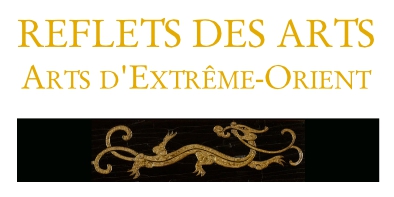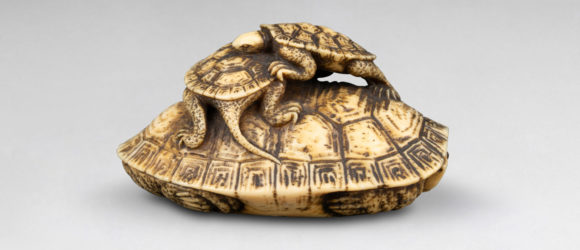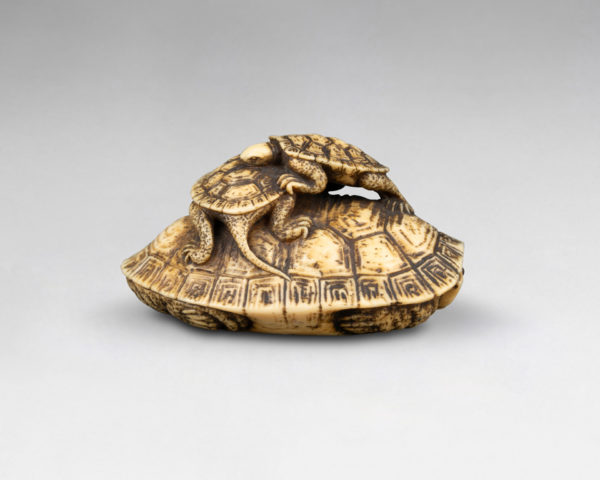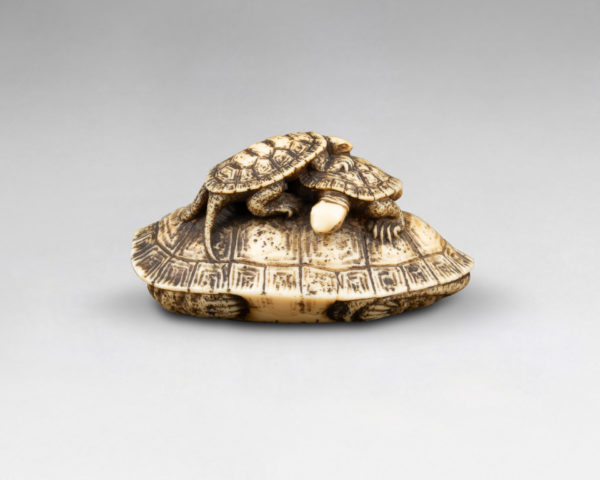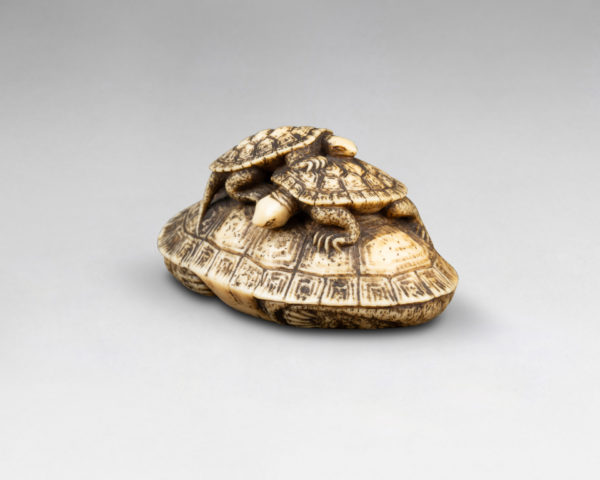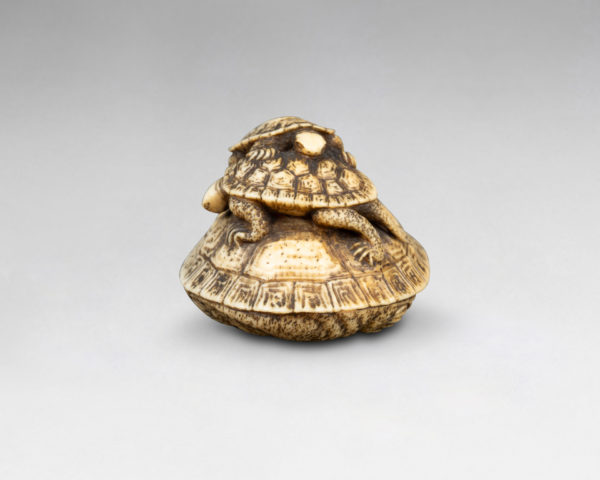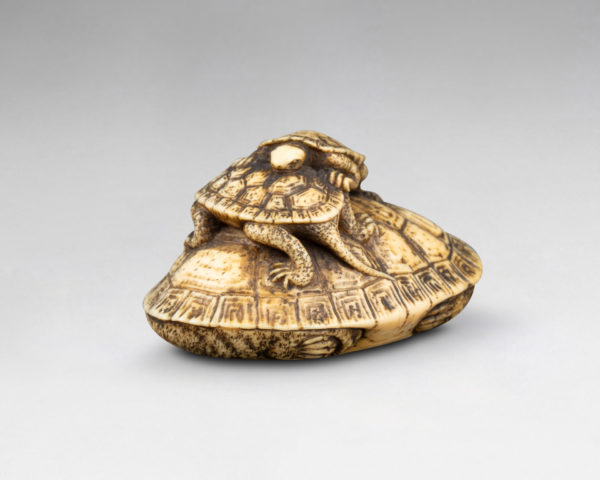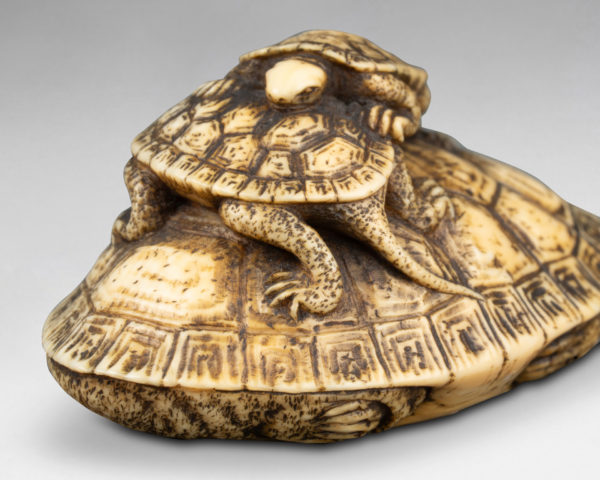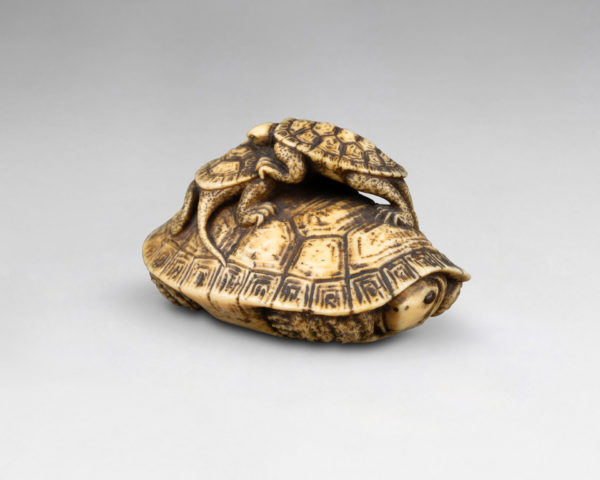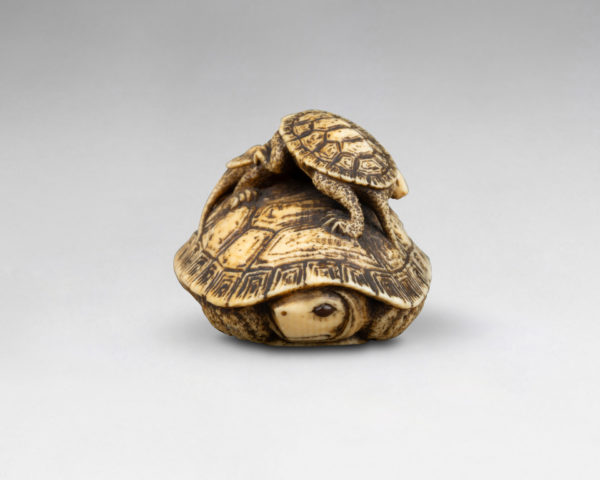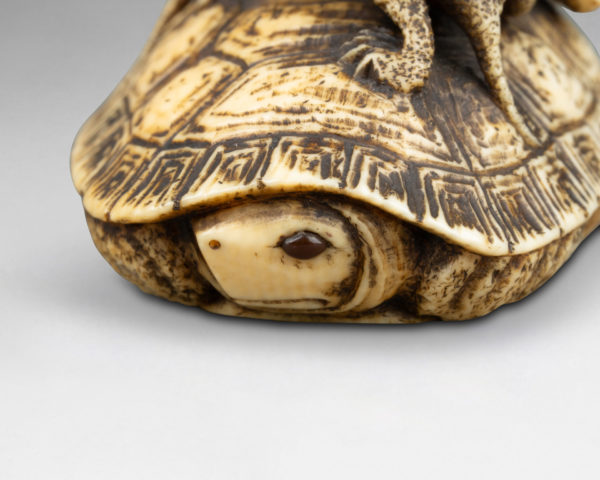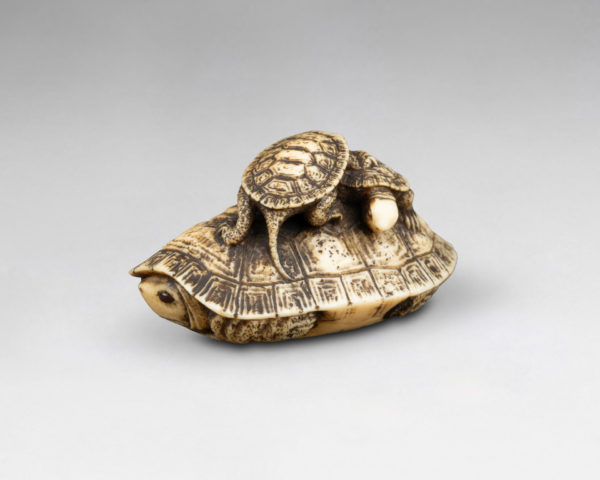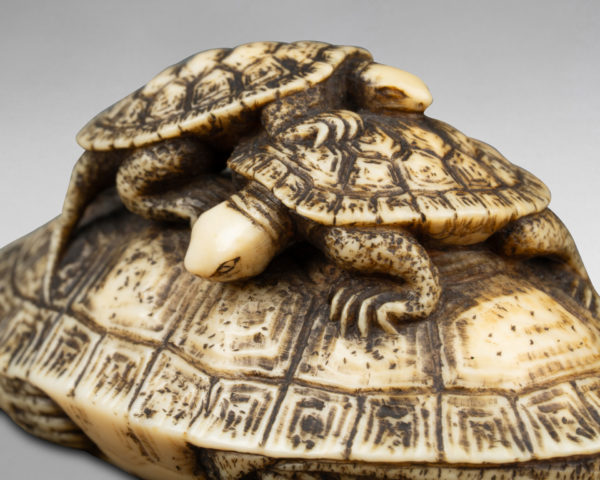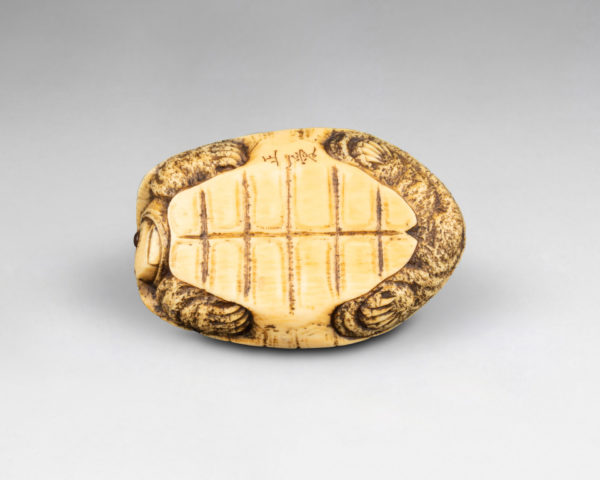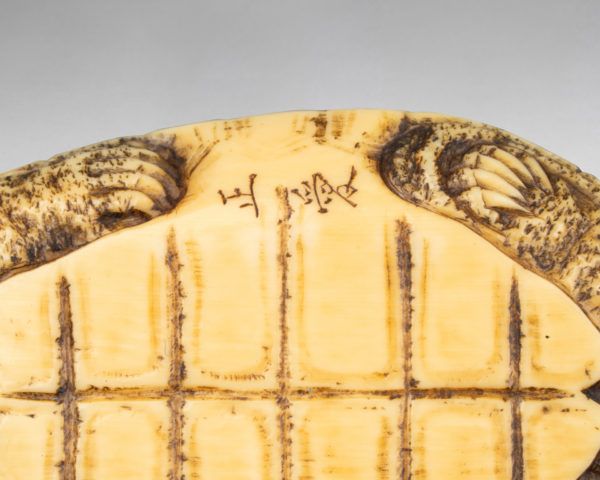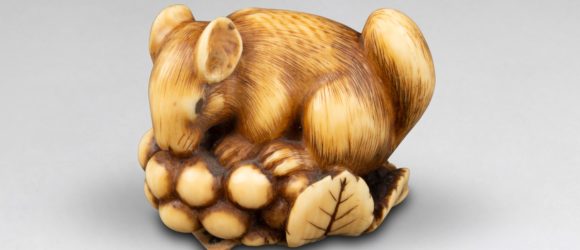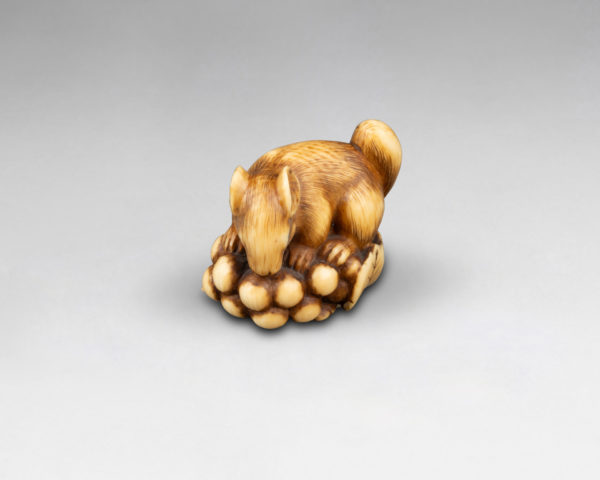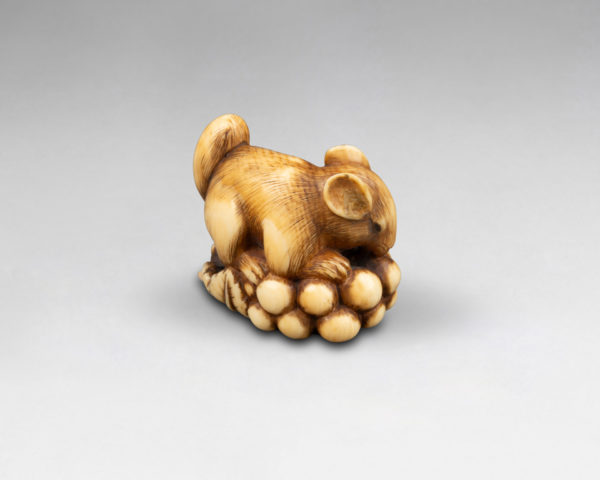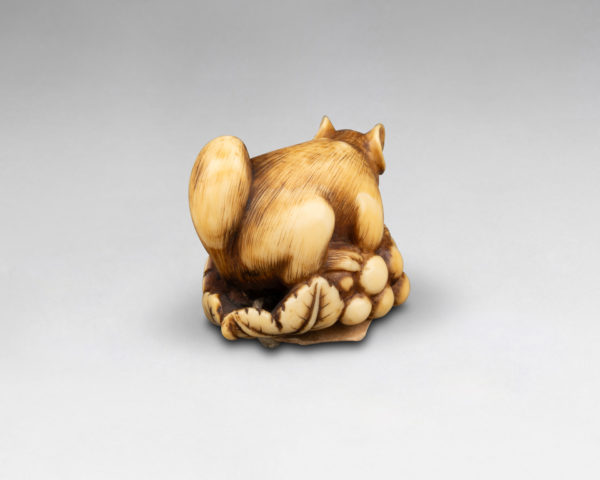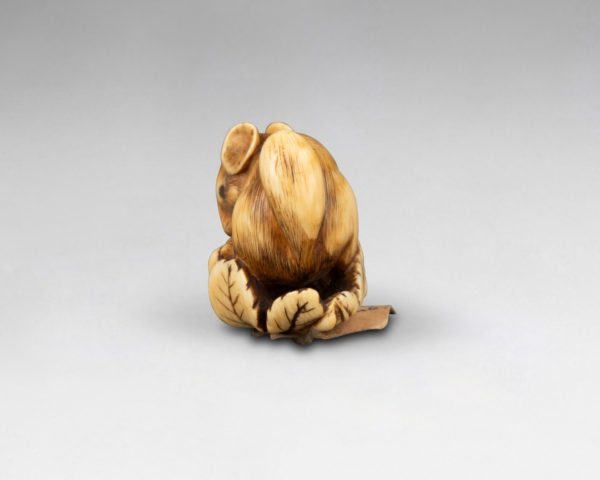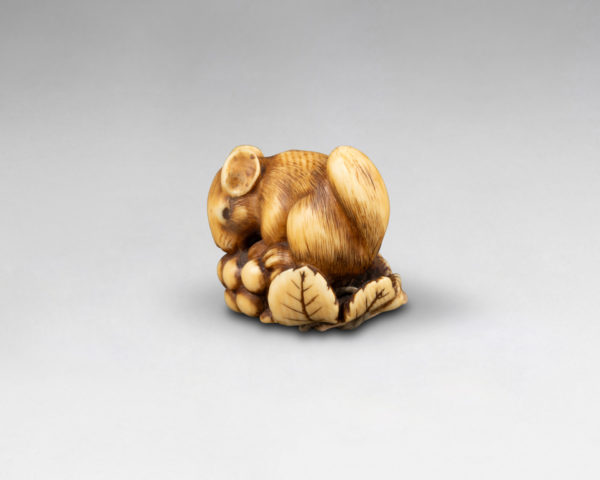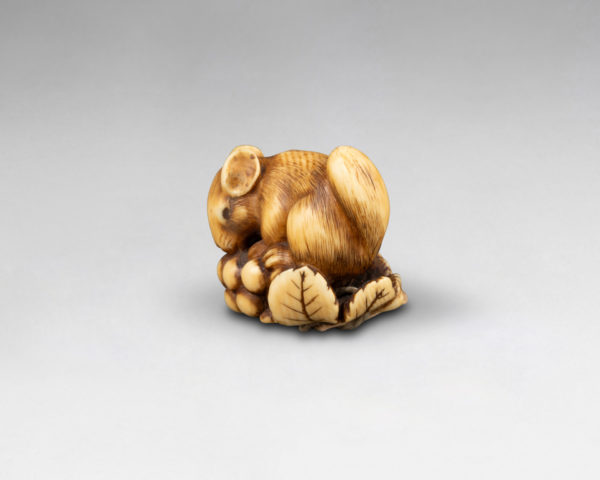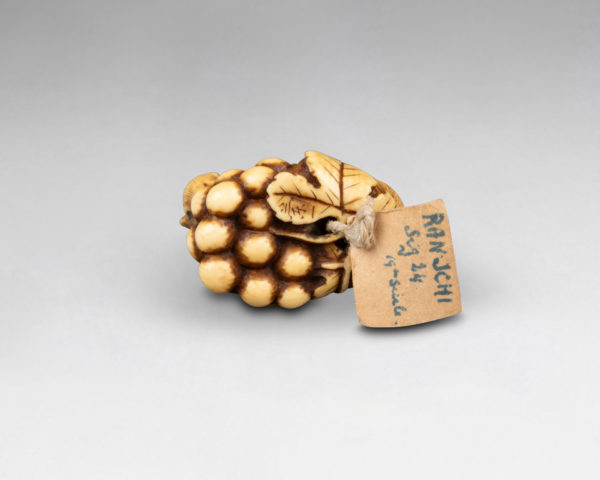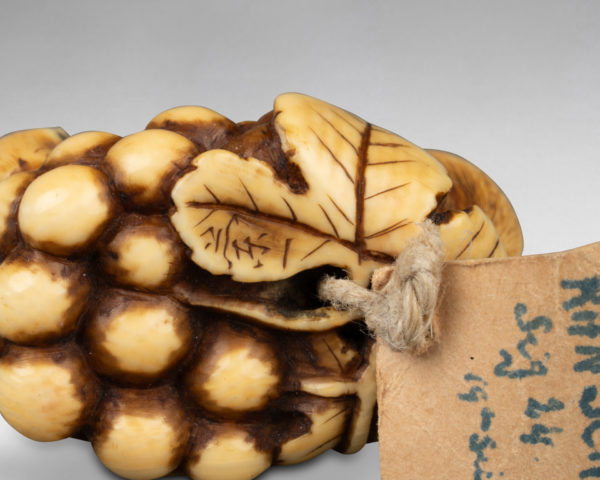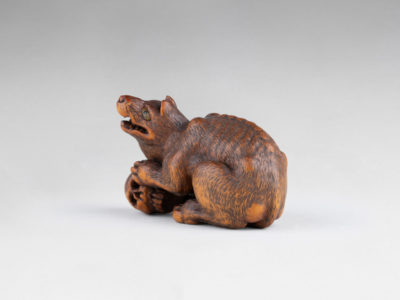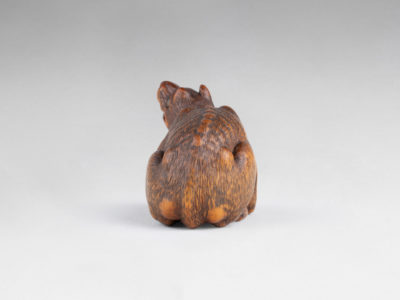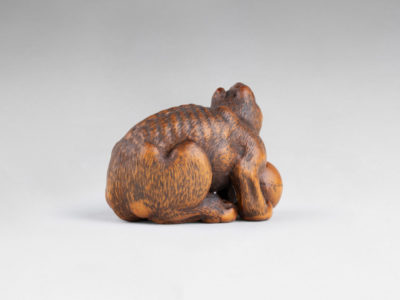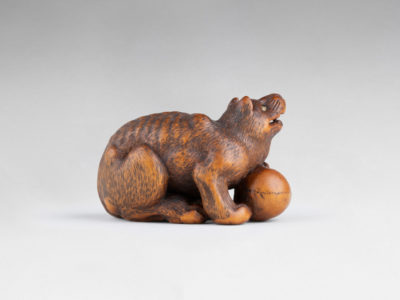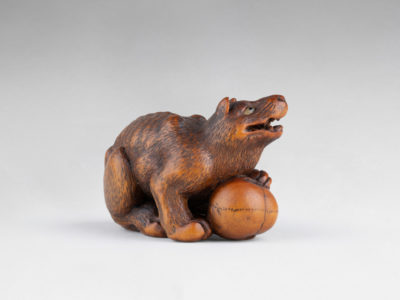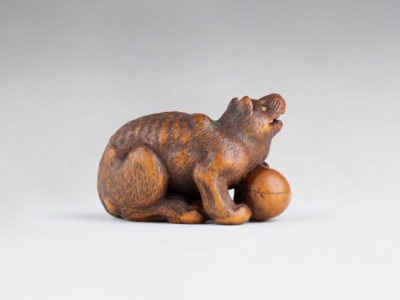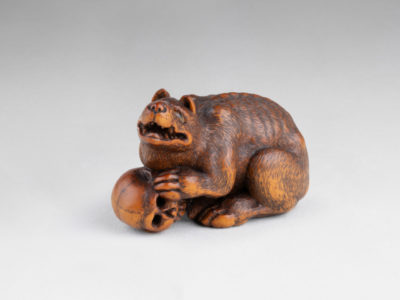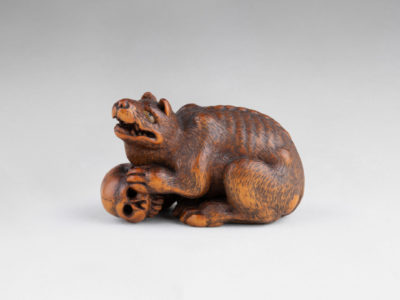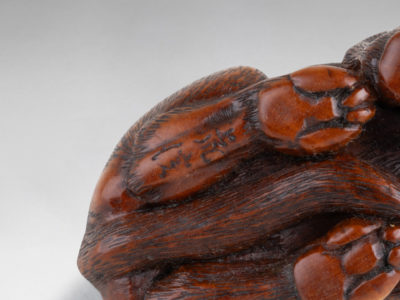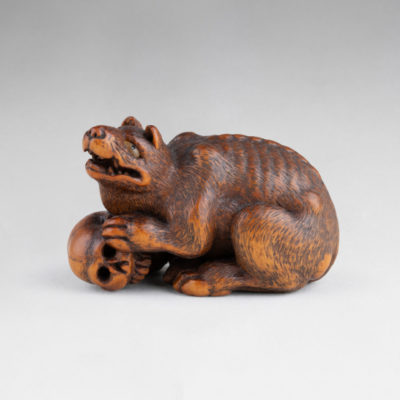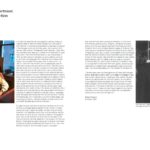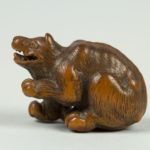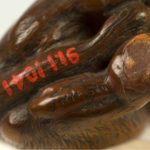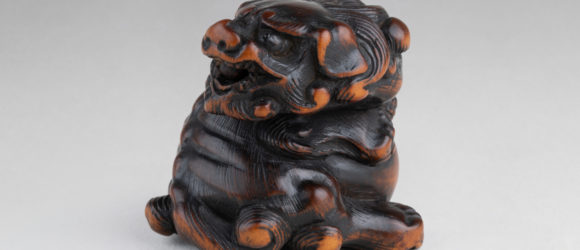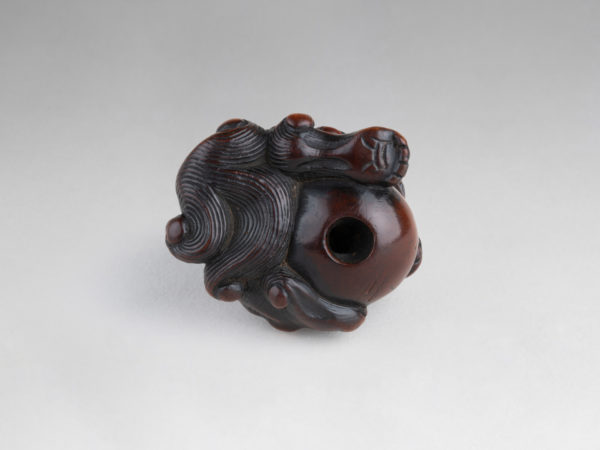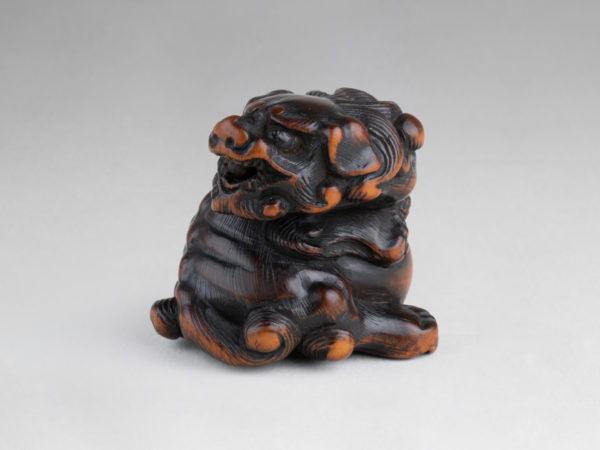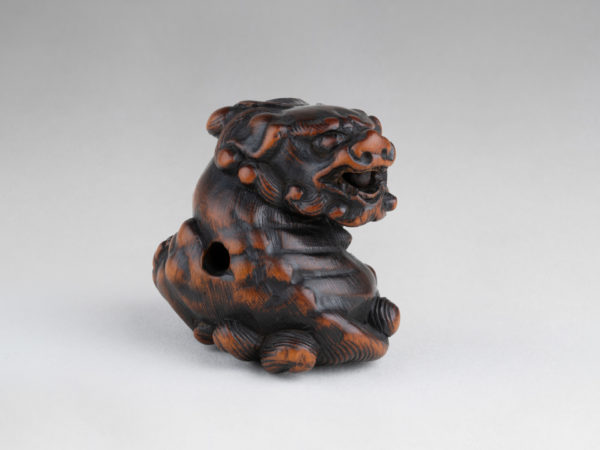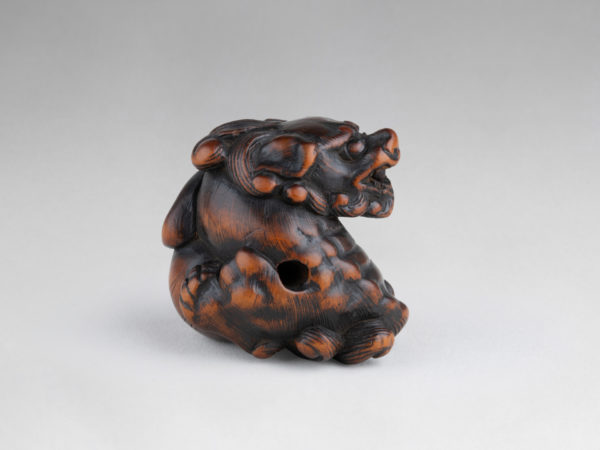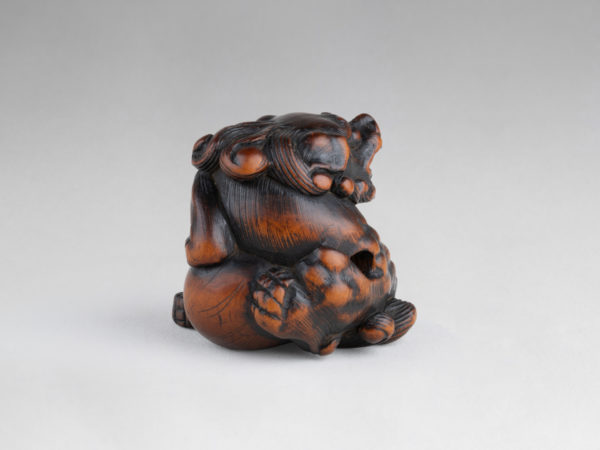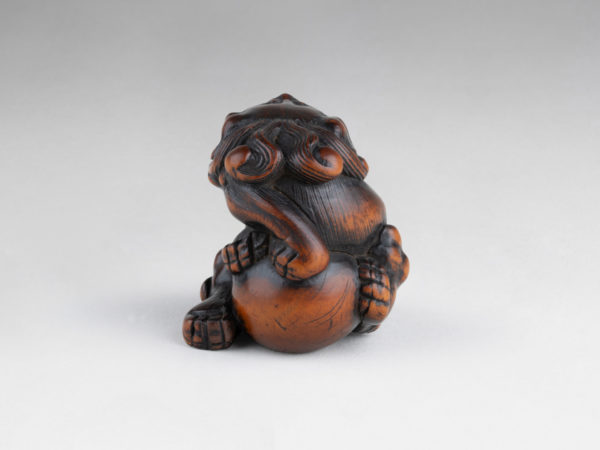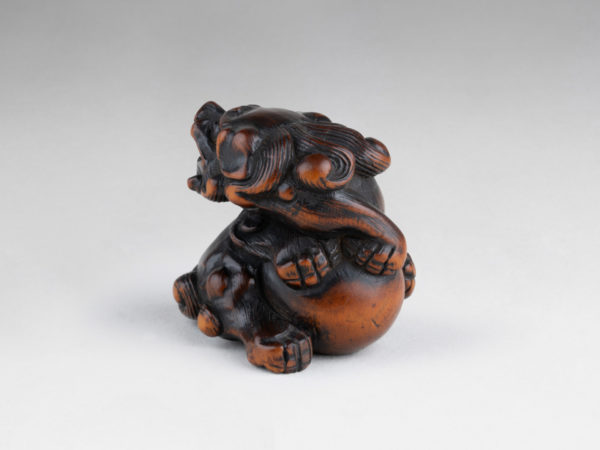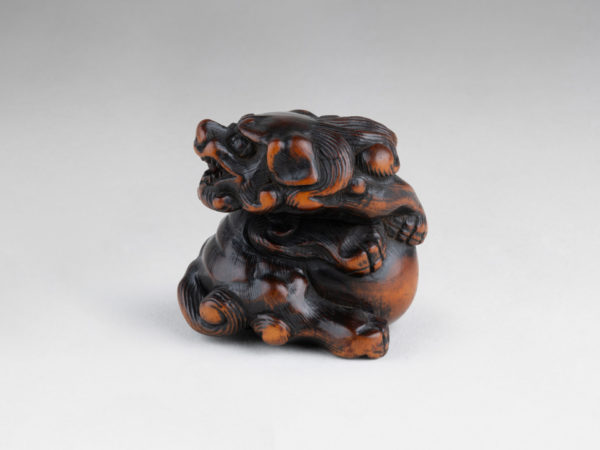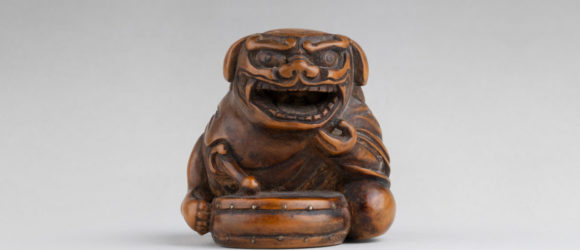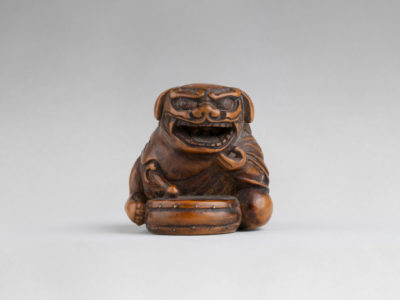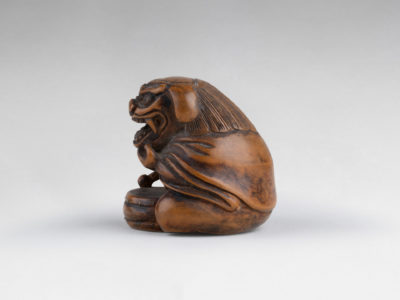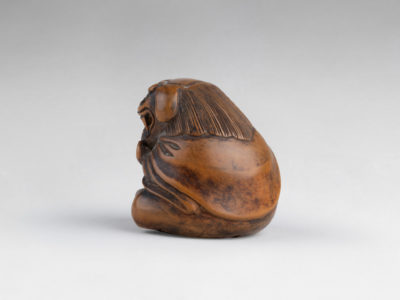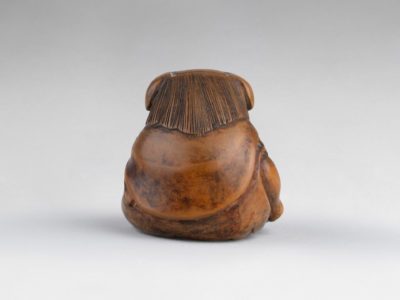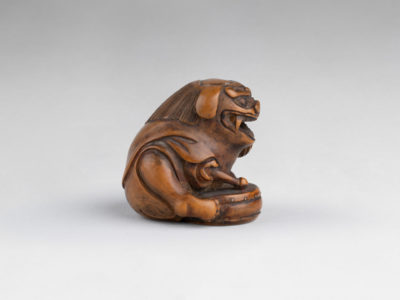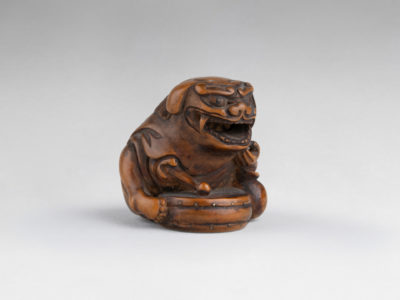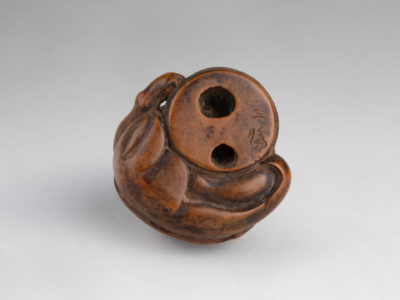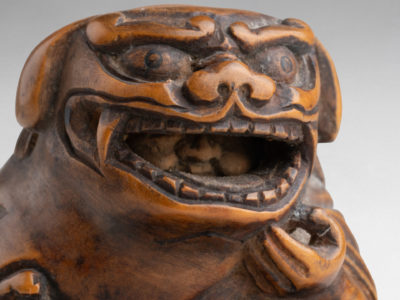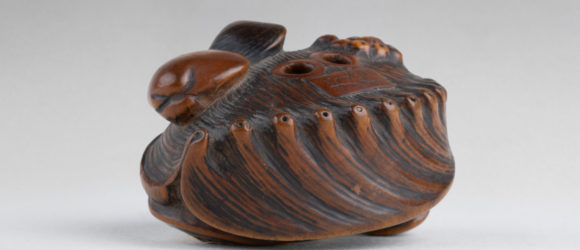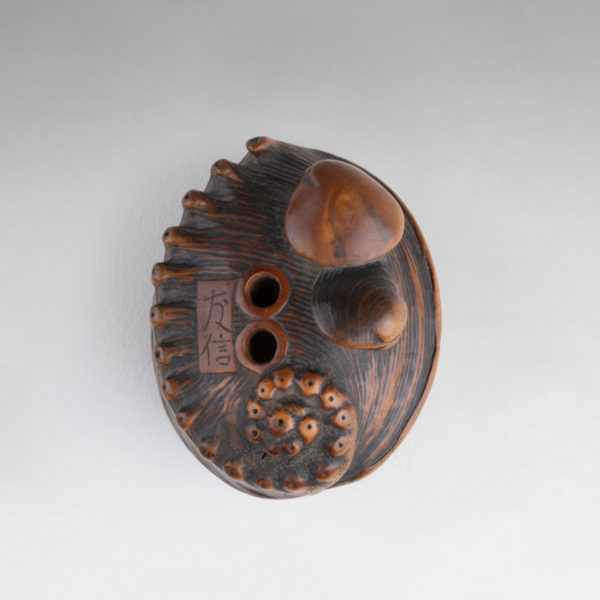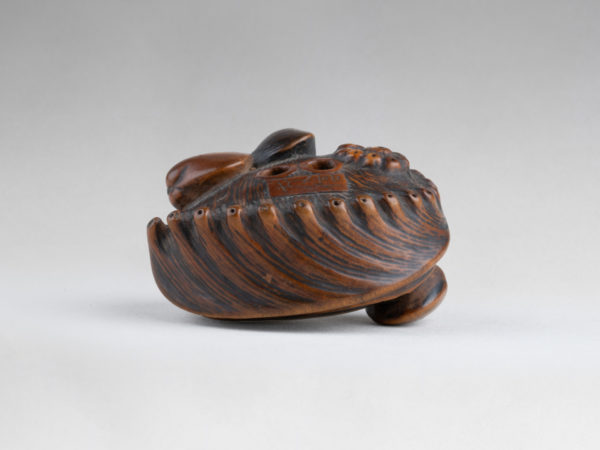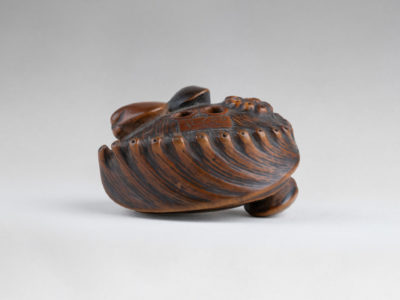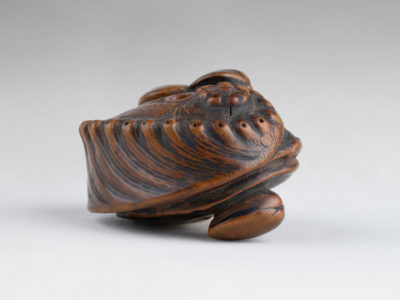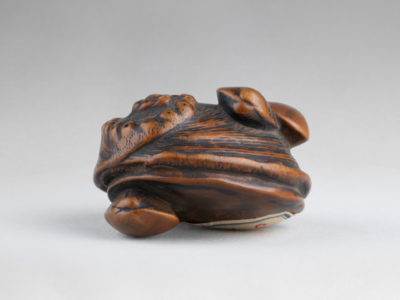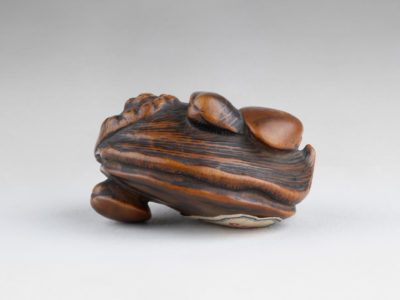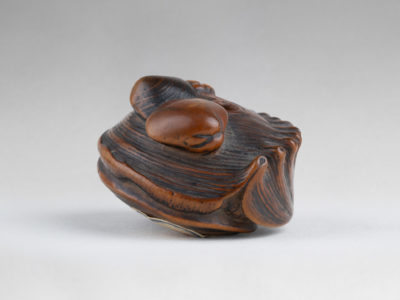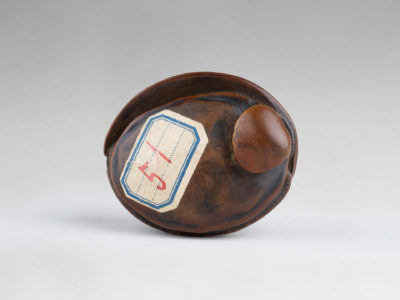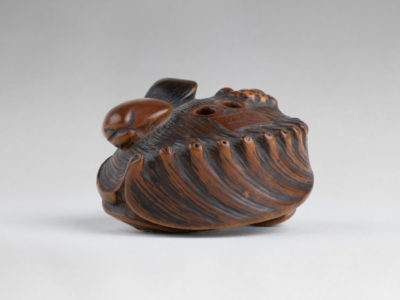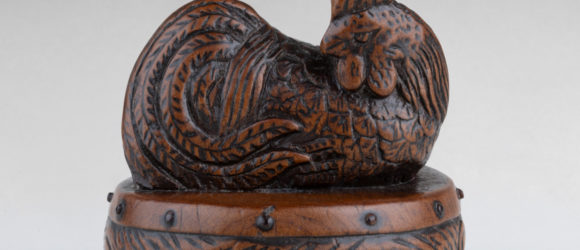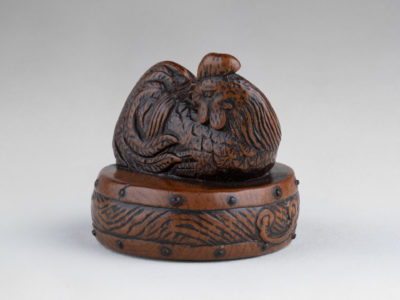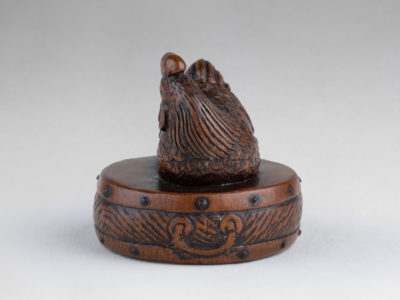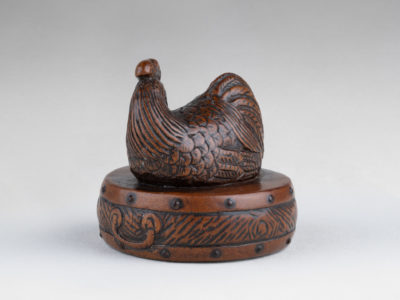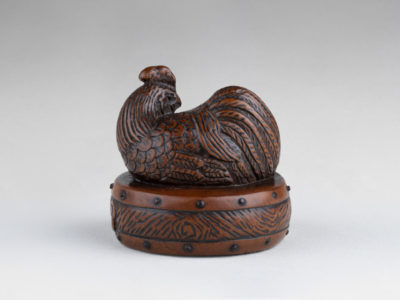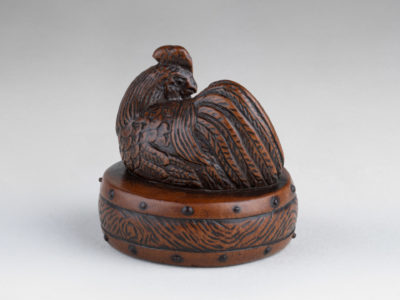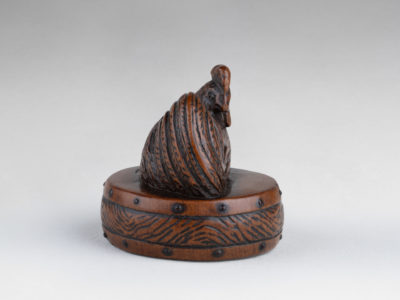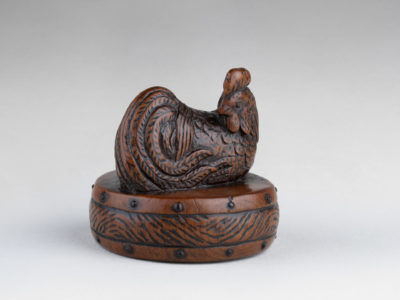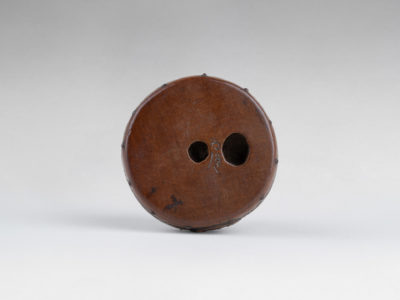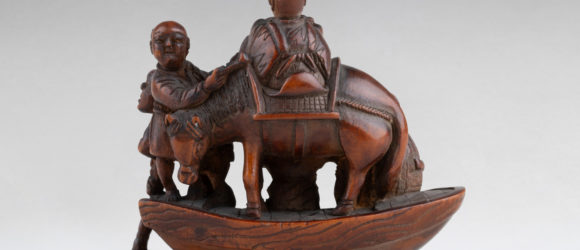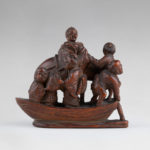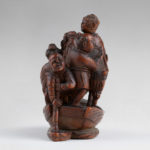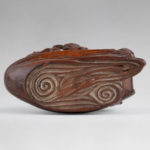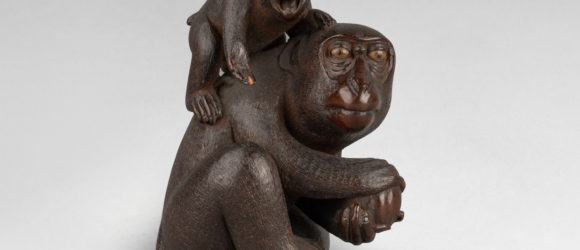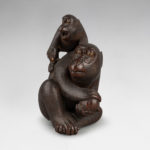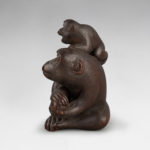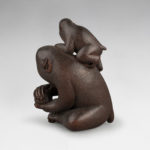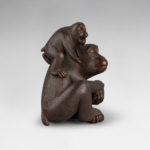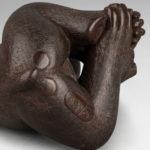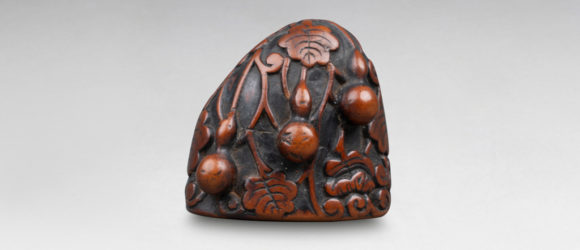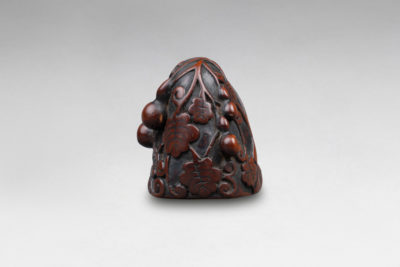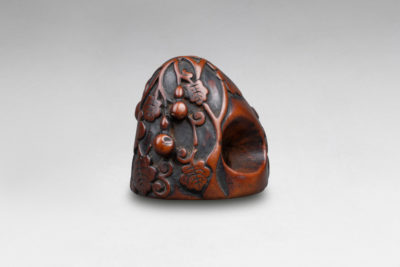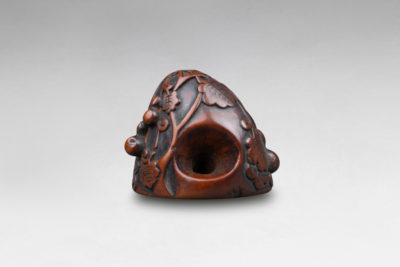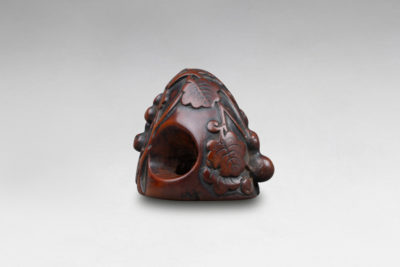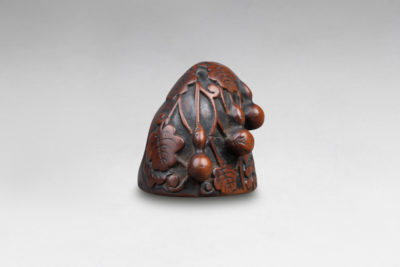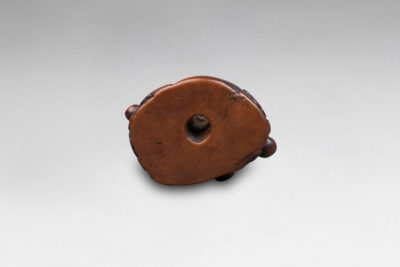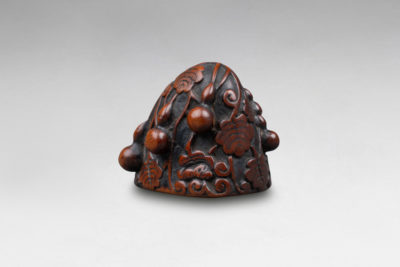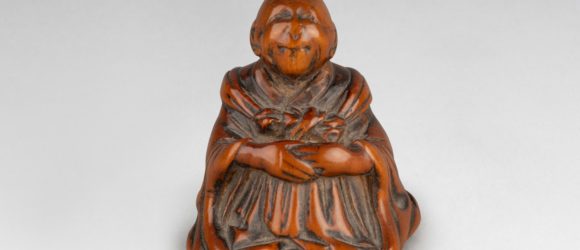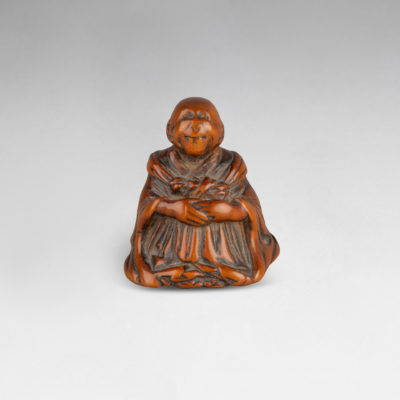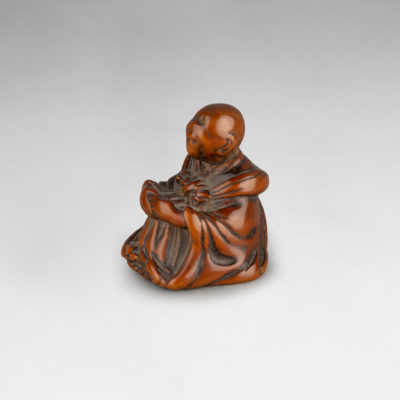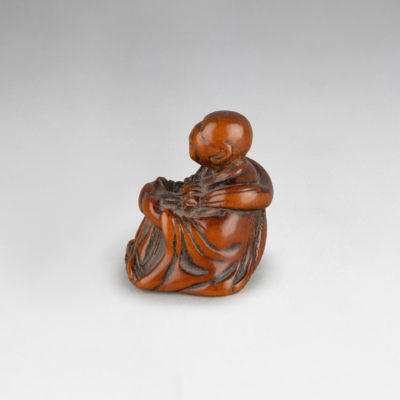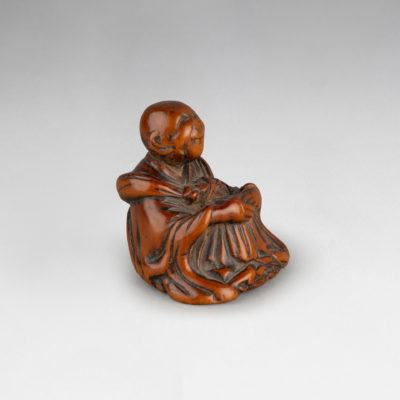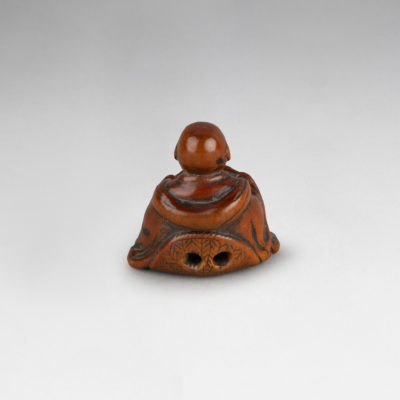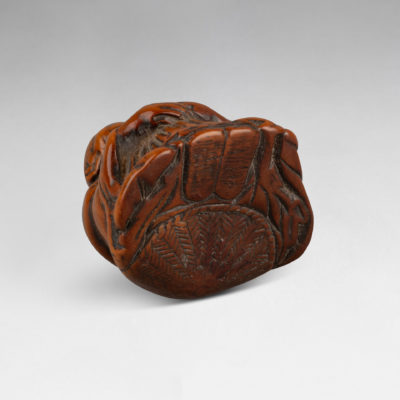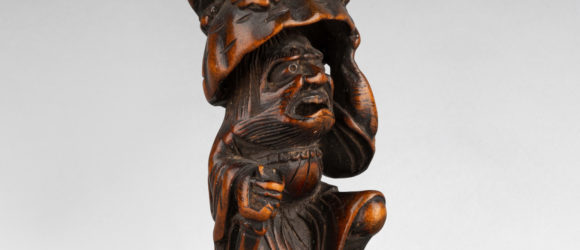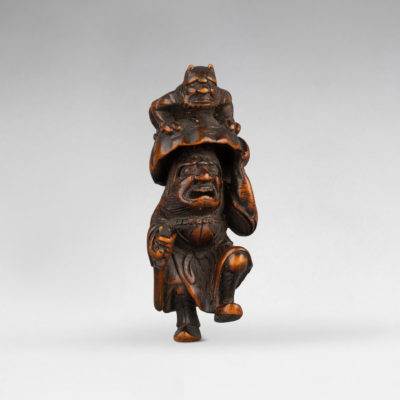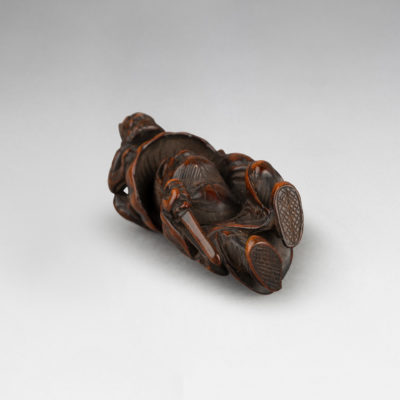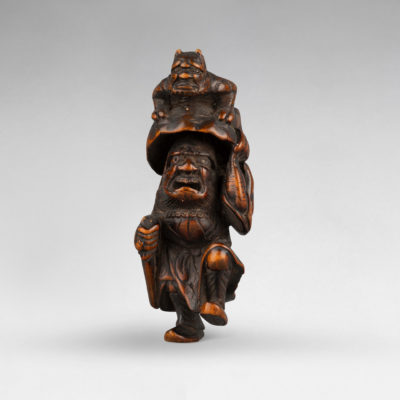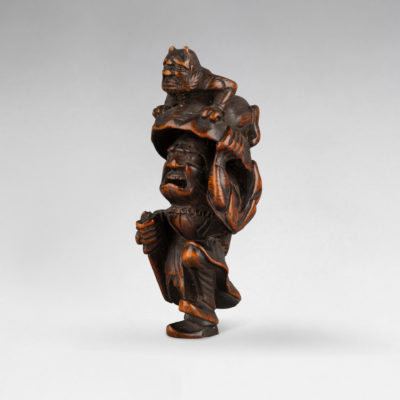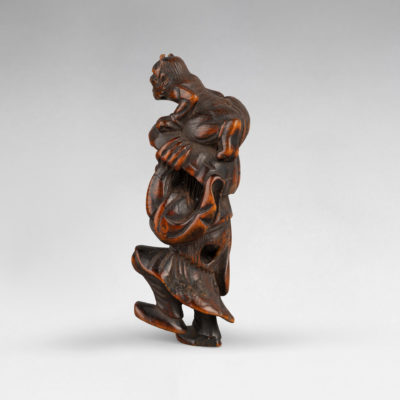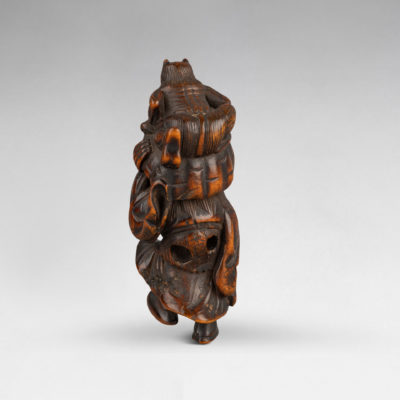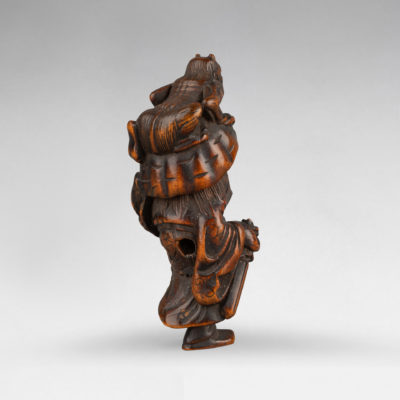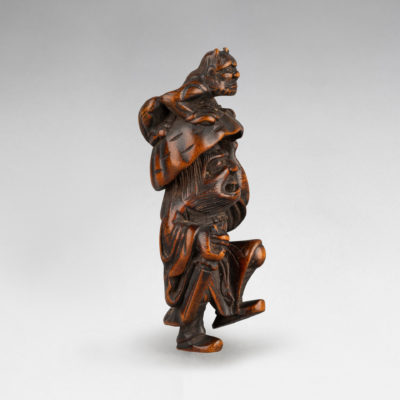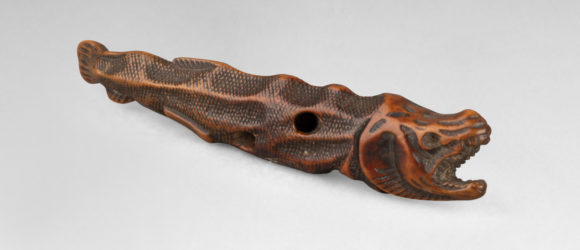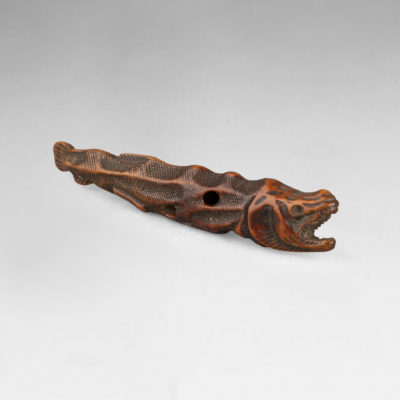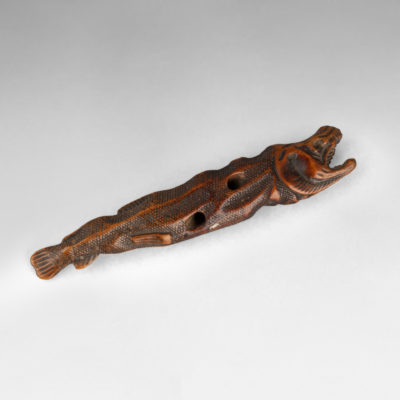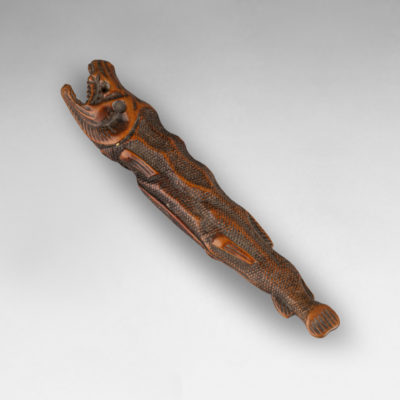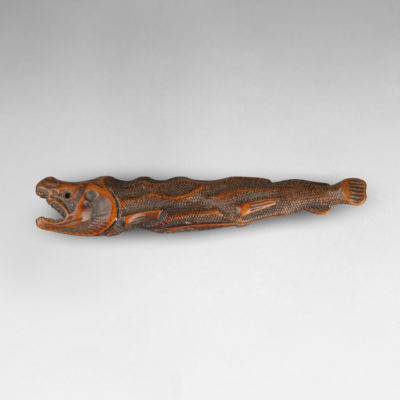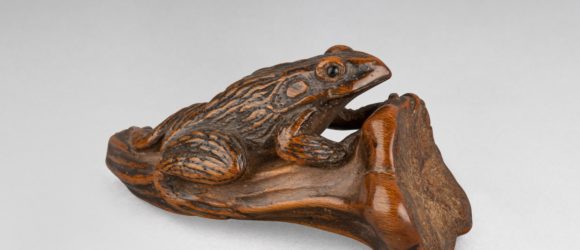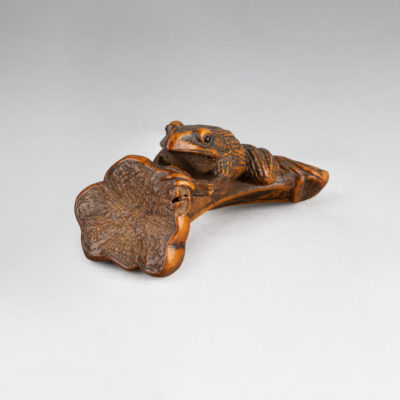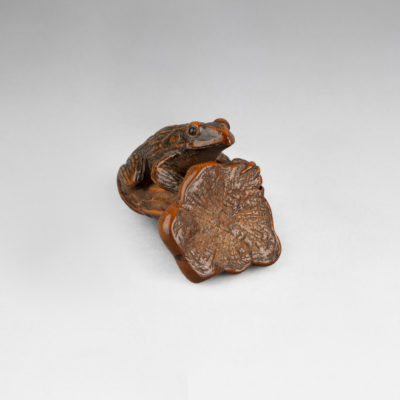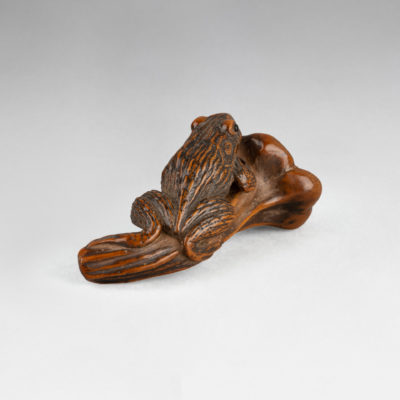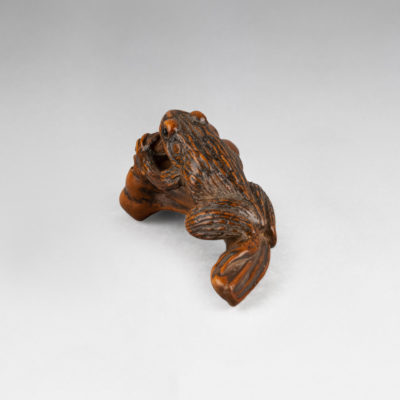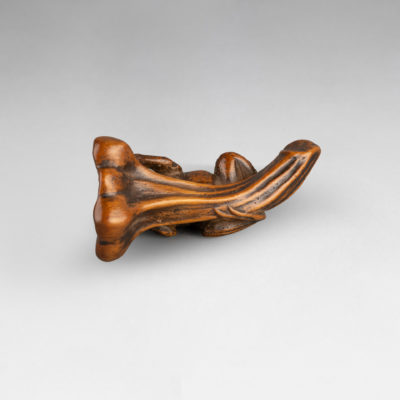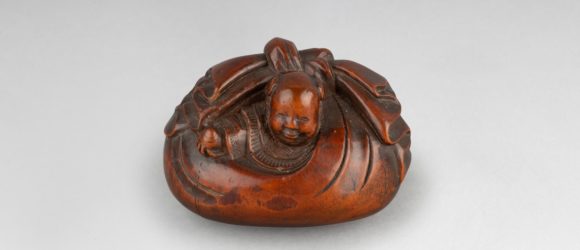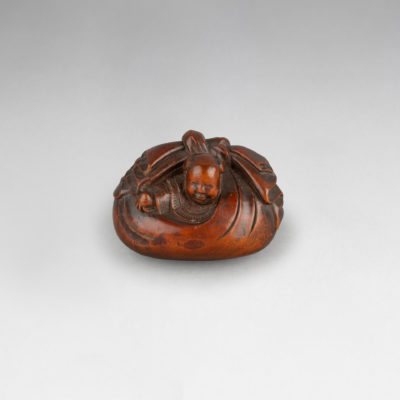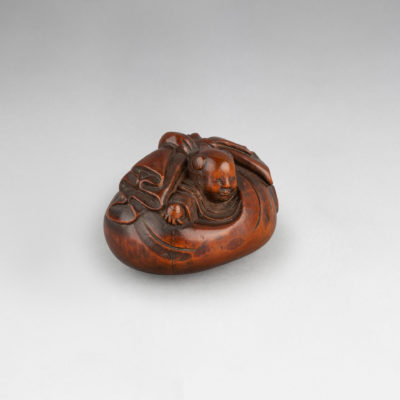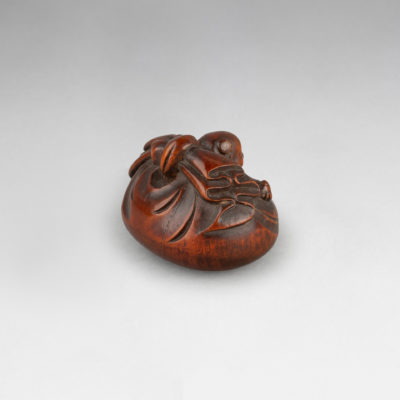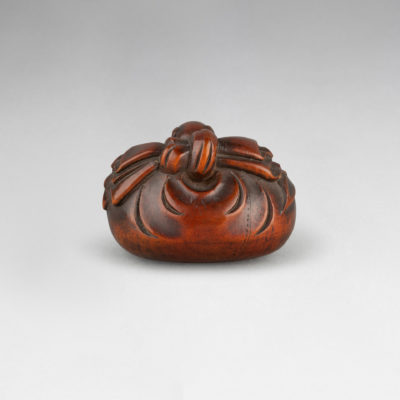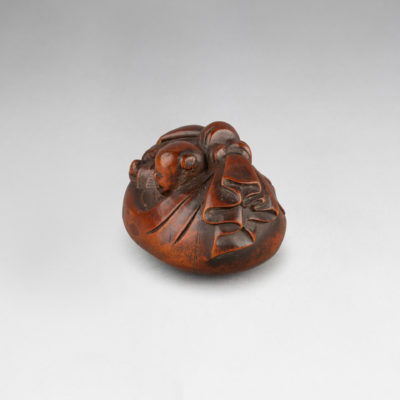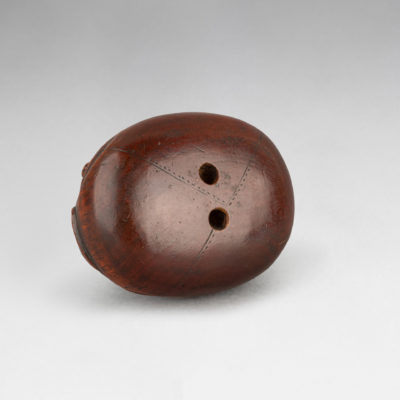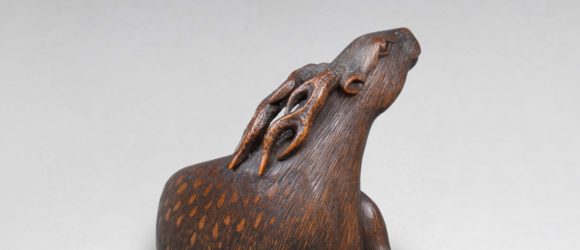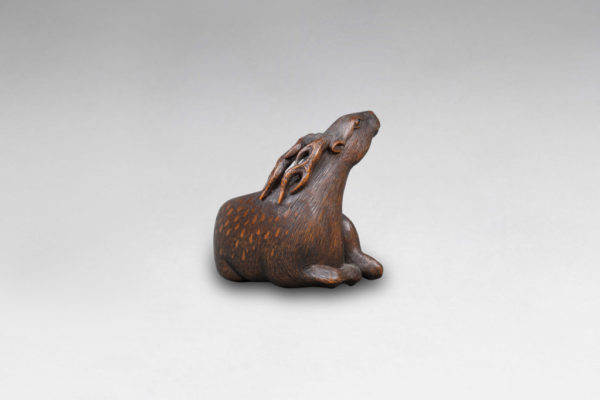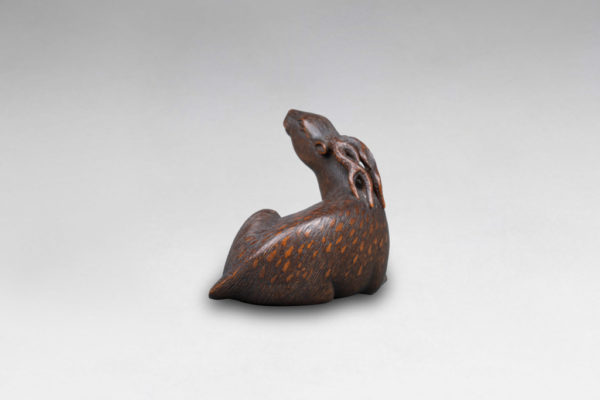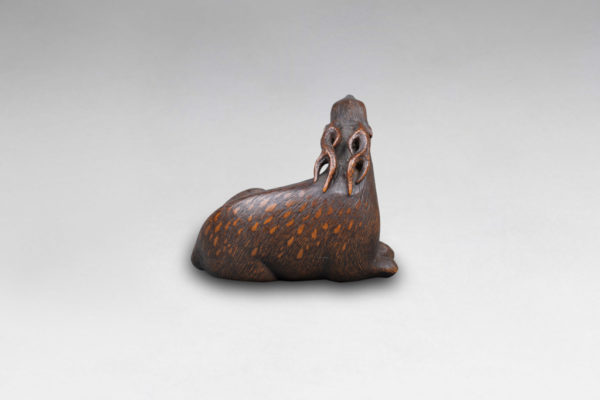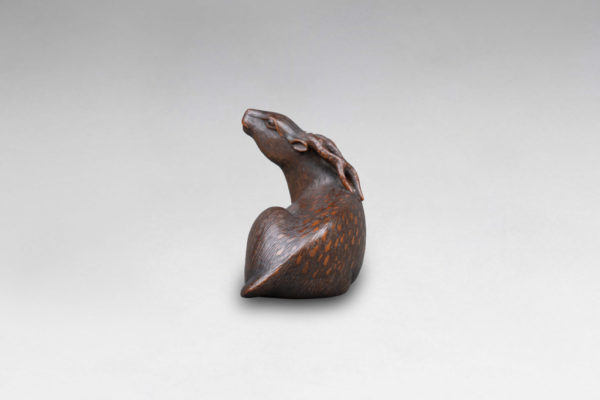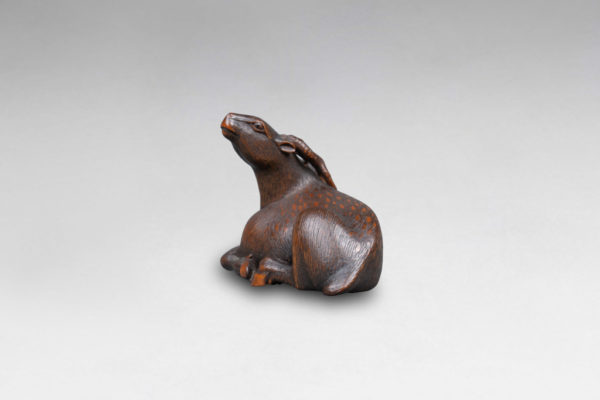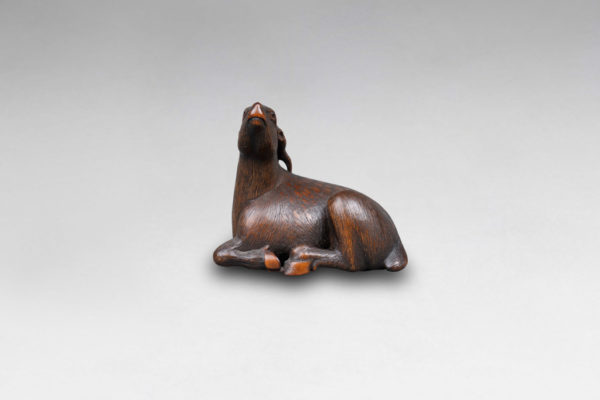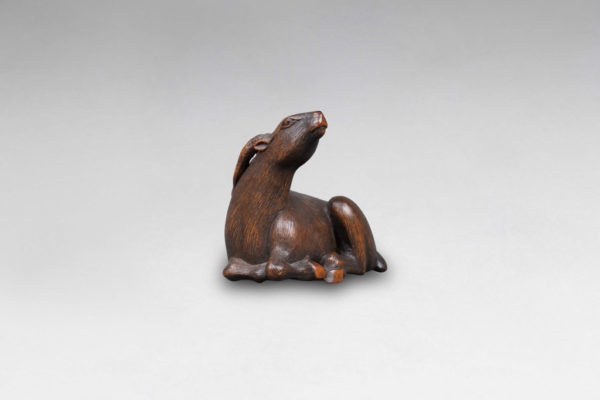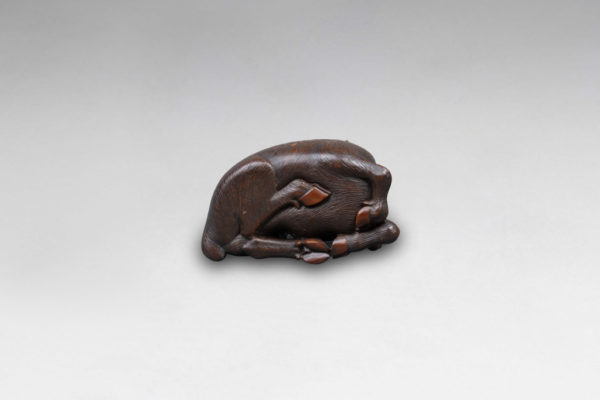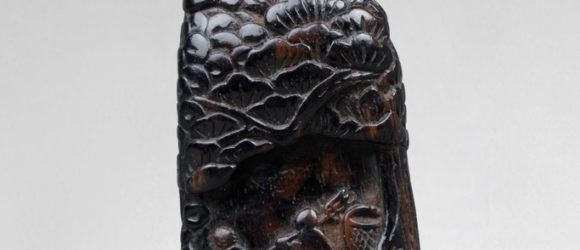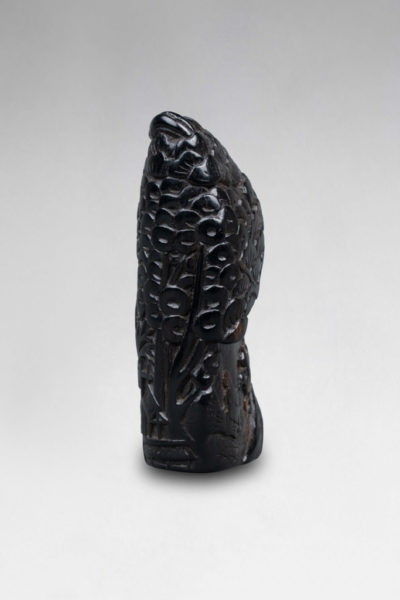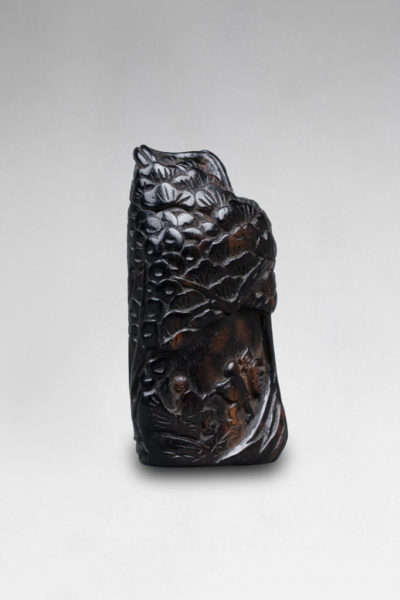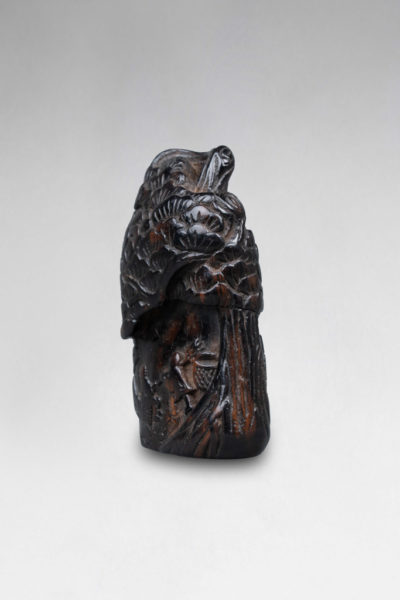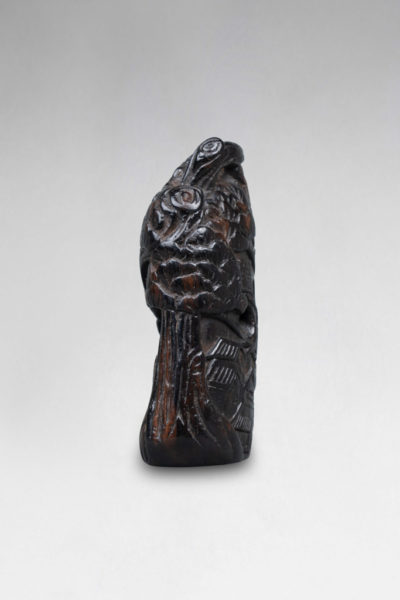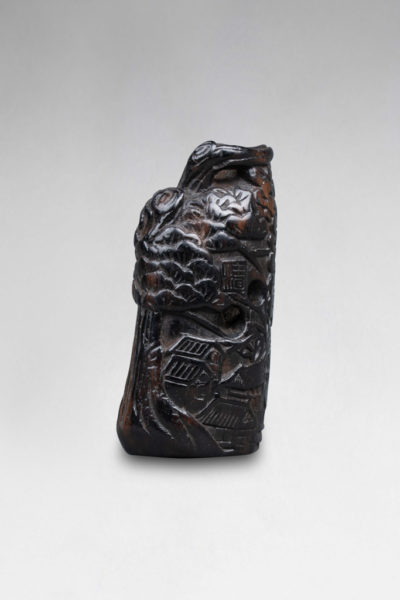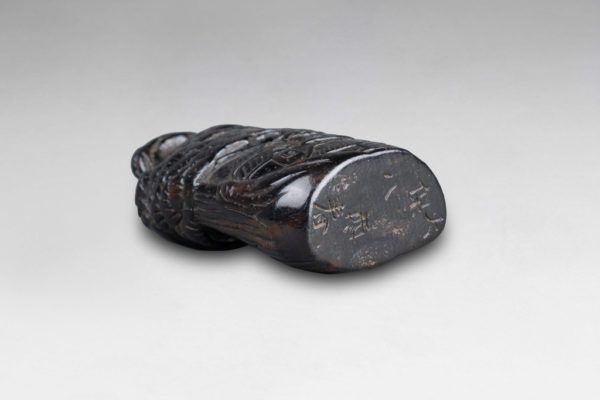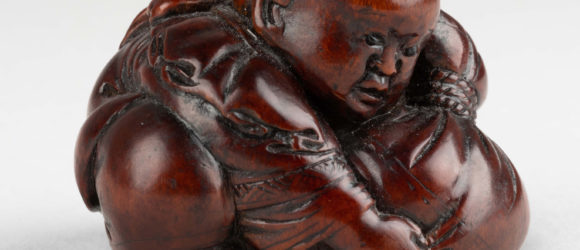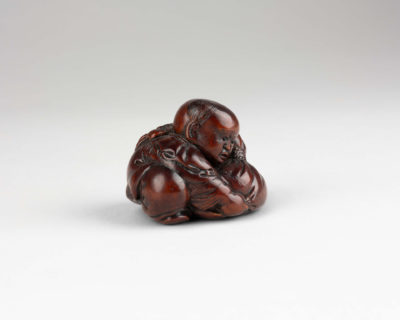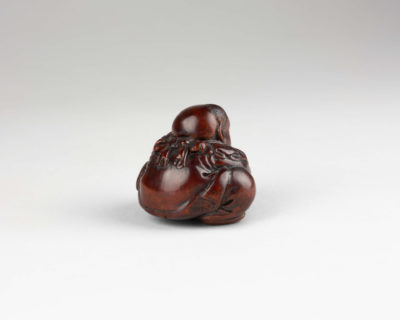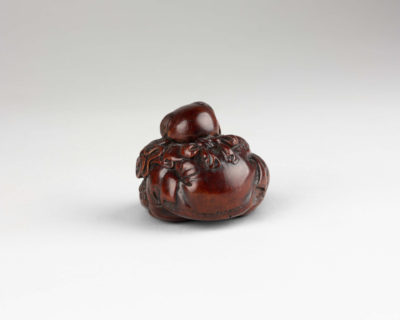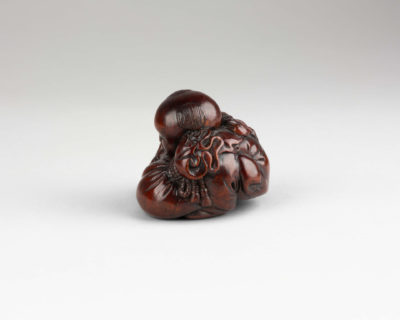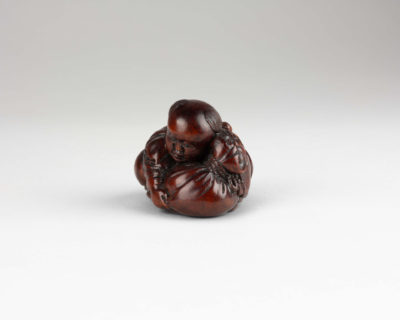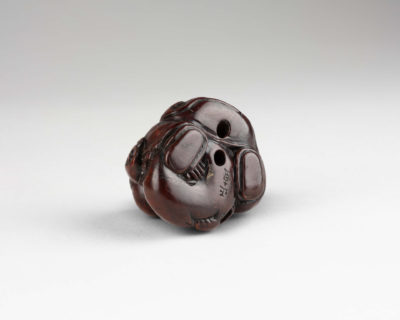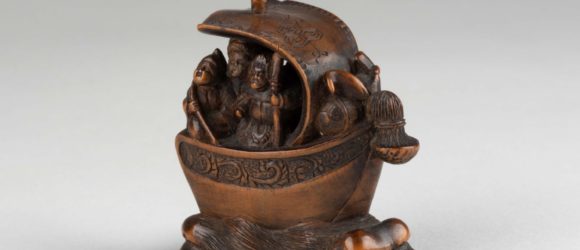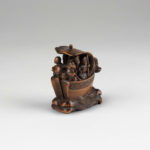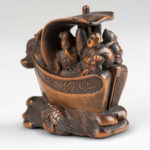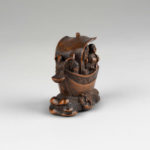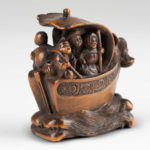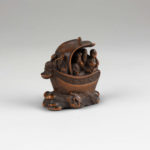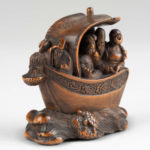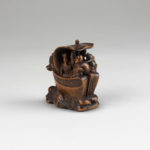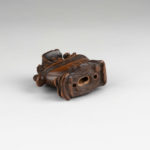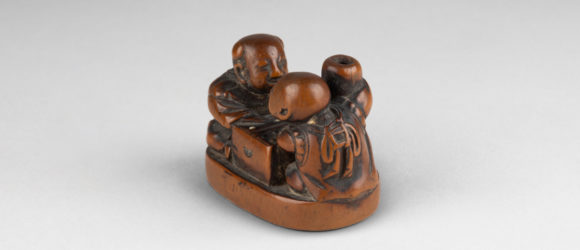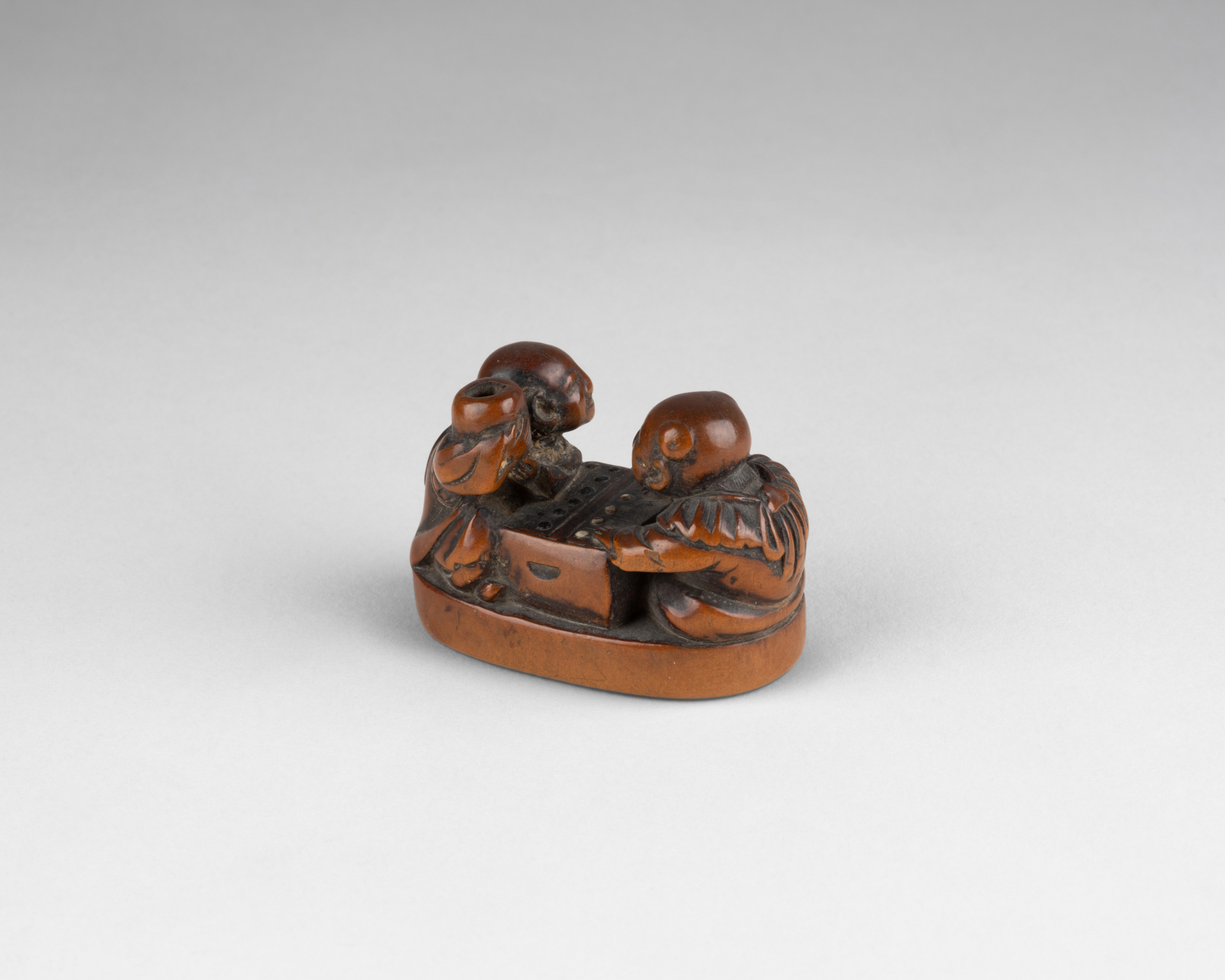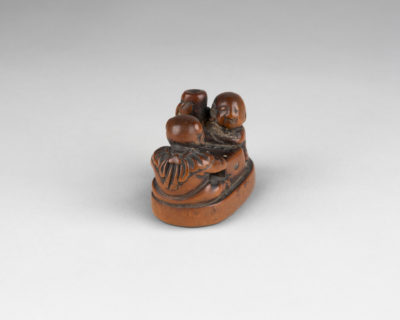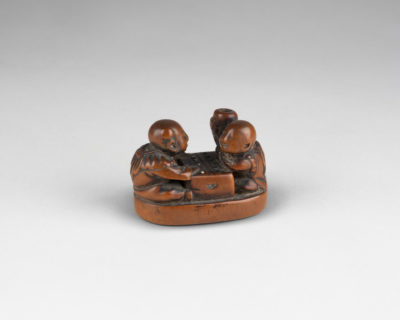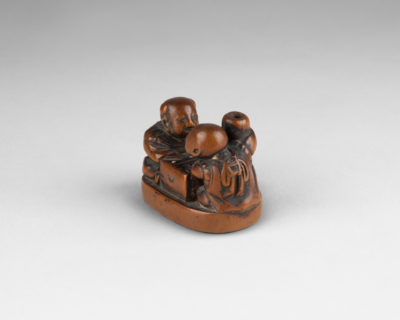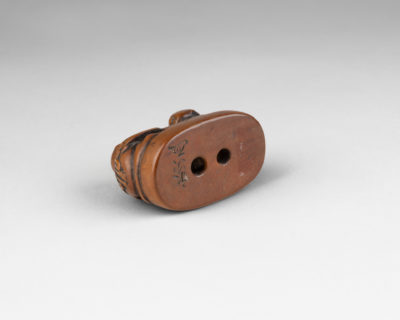Netsuke – Loir sur des fruits par Ranichi
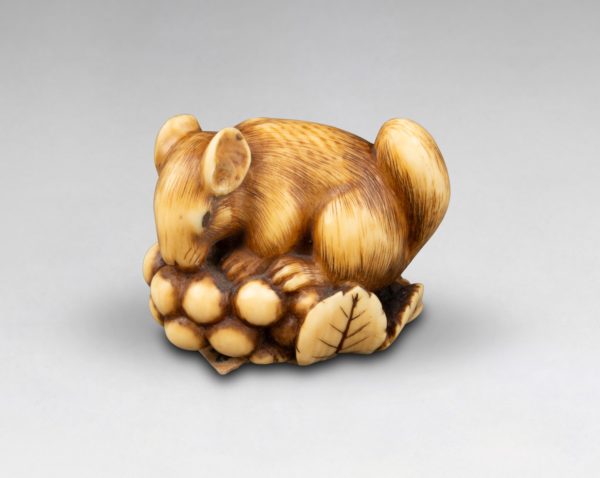
Netsuke en ivoire par Ranichi, représentant un loir perché sur une grappe de fruits. Hauteur : 2,8 cm. Japon Edo (1603-1868) fin du XVIIIe, début du XIXe siècle. CIC FR2409200296-K
Netsuke – Ivory netsuke by Ranichi representing a dormouse perched on a cluster of fruits. H: 2,8 cm. Japan Edo (1603-1868) end of 18th, early 19th century
Netsuke par Kokei – Exceptionnel modèle de loup
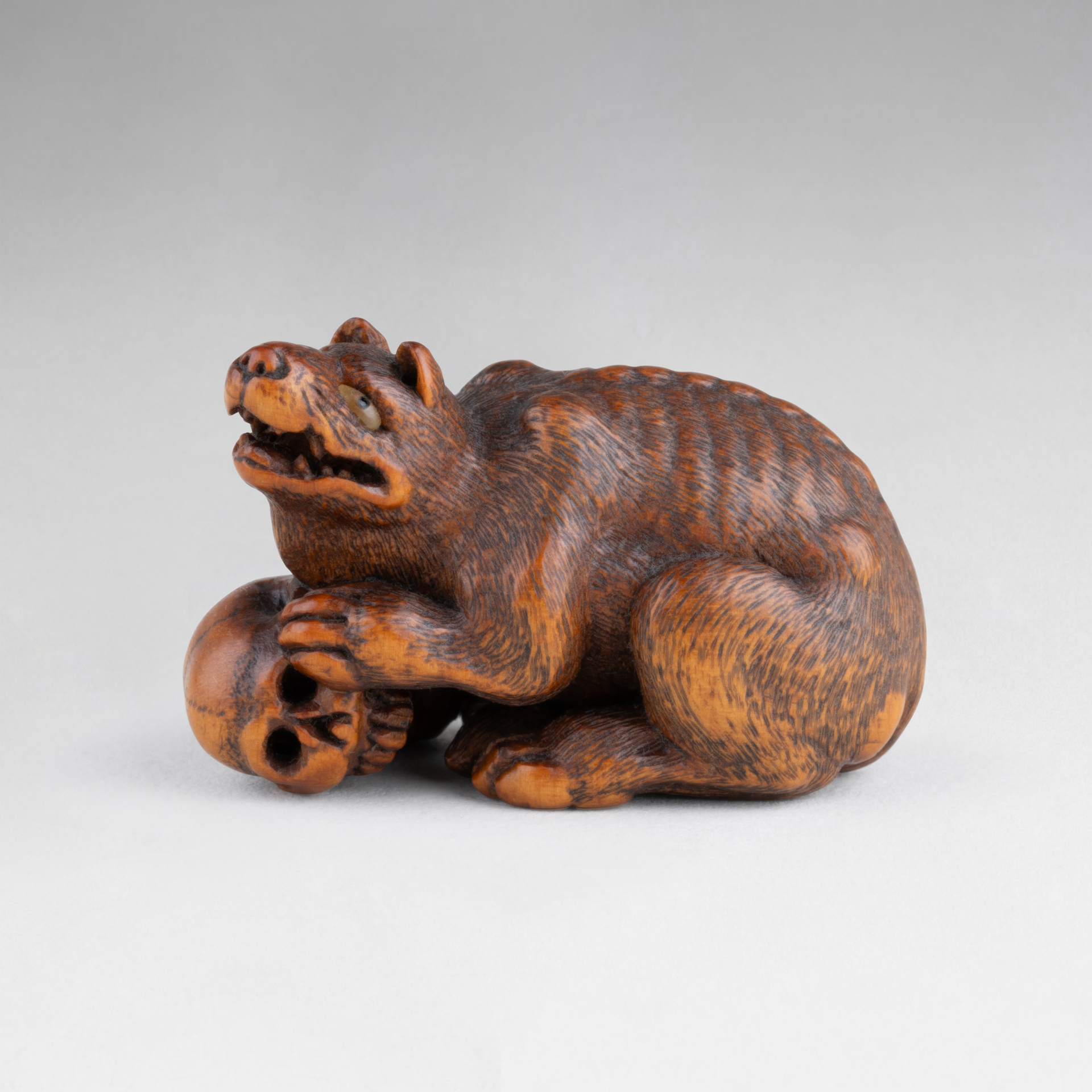
Netsuke par Kokei – Exceptionnel modèle d’un loup, la patte retenant un crâne. Les yeux sont en double incrustation. Japon Edo (1603-1968) XIXe siècle. Provenance : Collection Hartman. Mise en comparaison avec une pièce similaire de même qualité (ci-dessous), dont le crâne est manquant. Il s’agit d’une œuvre de Kokei située au MET de New York, Edward C.MOORE collection, 1891.
Netsuke by Kokei. A very important model of a wolf. A wild dog crouching over a skull, the eyes inlaid in horn and ebony. Japan Edo (1603-1868) 19th century. Provenance : Hartman Collection. A very similar exemple here attached, from the MET of New York, for the Edward C.MOORE collection, 1891.
Netsuke – Important shishi en buis sculpté
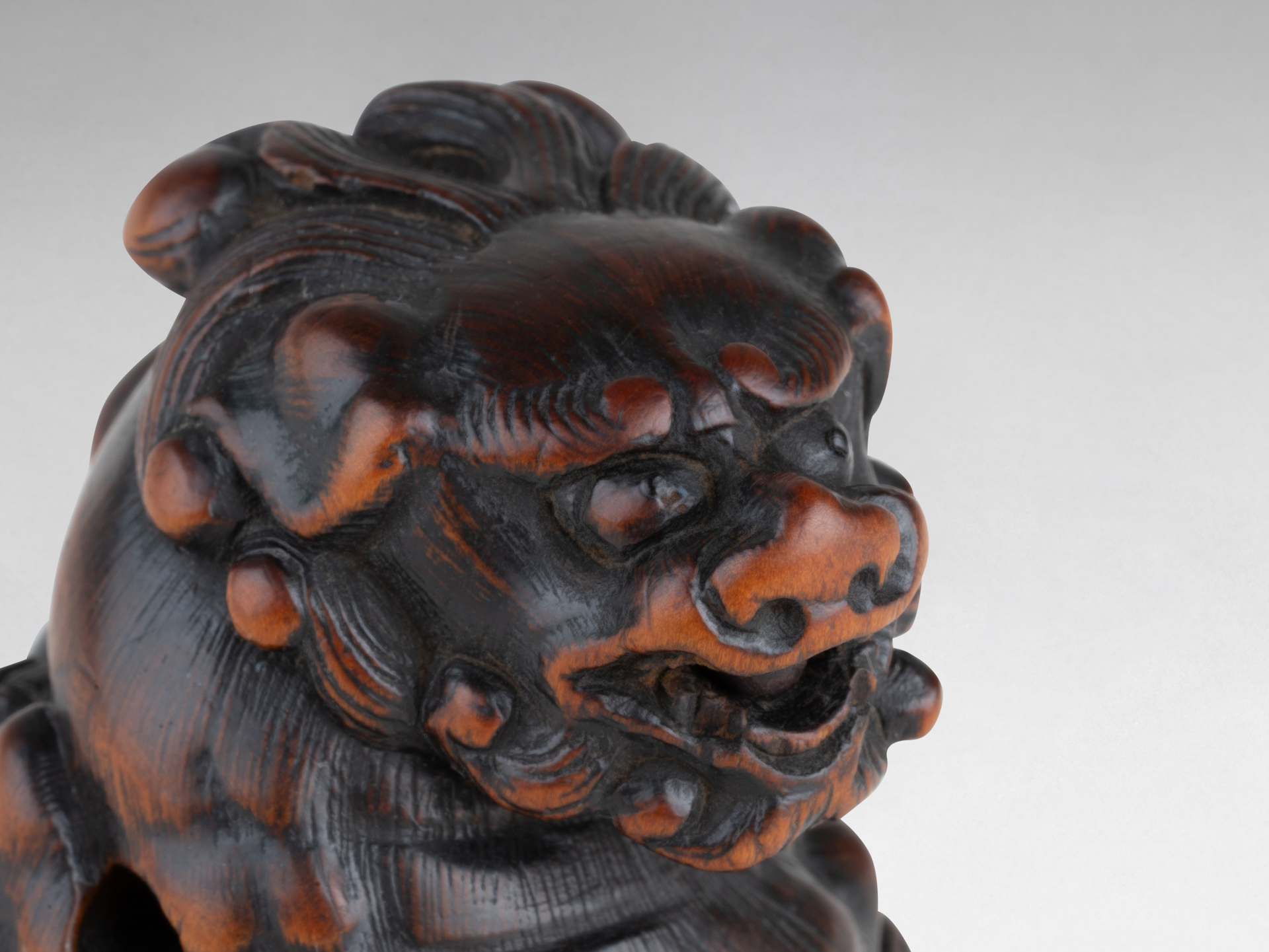
Netsuke – Important et puissant model de Shishi représenté assis, en bois sculpté (buis), La tête très expressive, complètement tournée vers l’arrière, les pattes avant en mouvement, reposant sur sa balle. Incrustations pour les yeux. Très belle patine naturel du bois. Hauteur : 3,4 cm. Japon Edo (1603-1868) 18e siècle. Provenance : Ancienne collection Hartman.
Netsuke – A strong and compact model of a shishi seated (Chinese mythical lion), powerfully carved and with a beautiful natural patina. Its head completely turned back to the right, the paws turning on a ball. Eyes are inlaid. Height : 3,4 cm. Japan Edo (1603-1868) 18th century. Provenance : From the Hartman collection.
Netsuke – Shishimaï, en bois sculpté
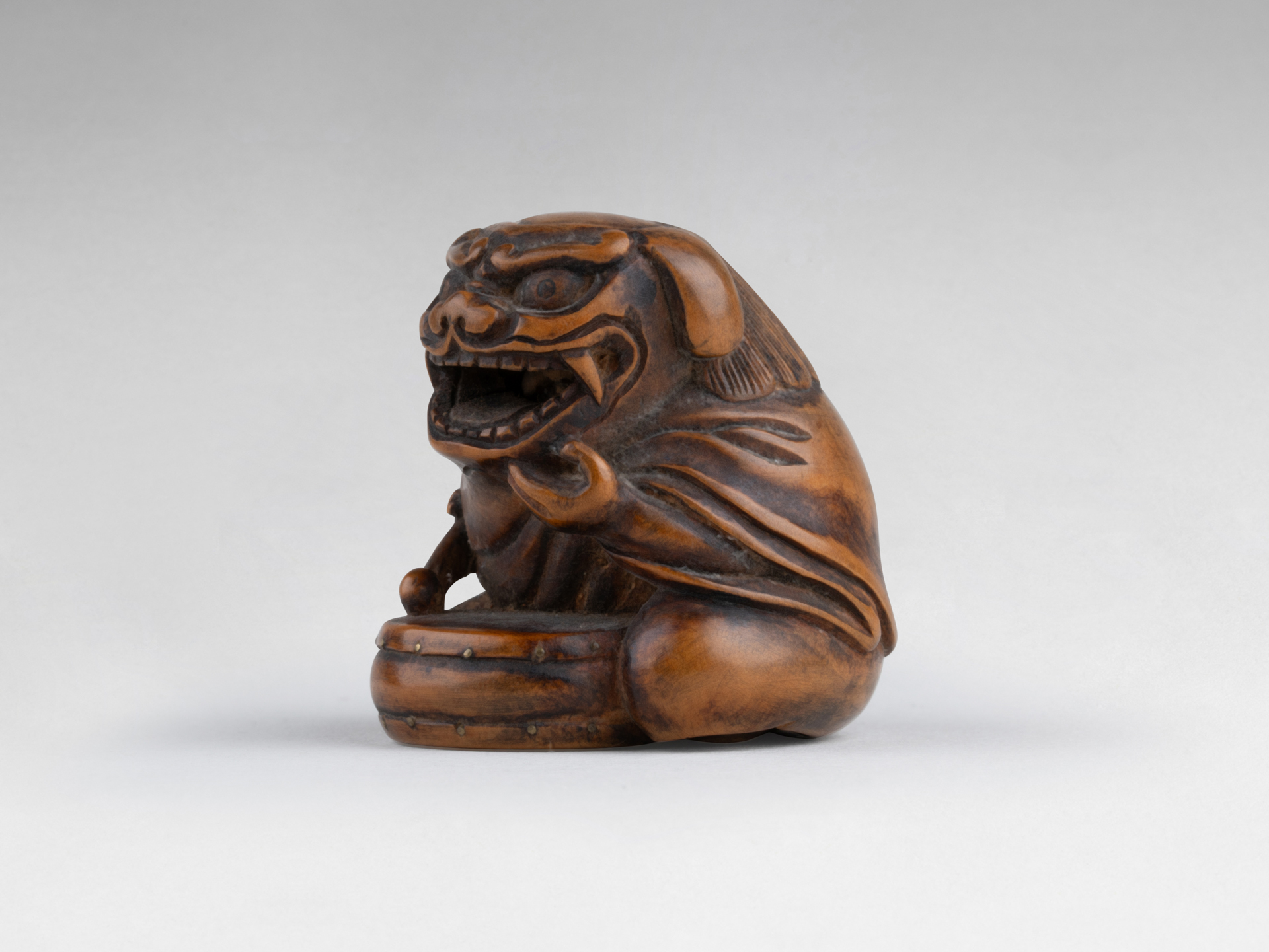
Netsuke – Shishimaï. En bois sculpté, il représente un jeune homme vétu du costume du Shishi, jouant du tambour. La tête du jeune homme est visible sous le masque. Japon Edo (1603-1868) XIXe siècle
Netsuke – Shishimaï. Wood sculpture of a man wearing a mask of Shishi, playing drum. We can see the face under the mask. Japan Edo (1603-1868) 19th century.
Netsuke par Tomonobu, Coquillages
Netsuke par Tomonobu – Coquillages. Palourdes sur un ormeau. Très belle patine naturelle. Signé Tomobonu dans un cartouche. Japon Edo (1603-1868) 18e siècle. Une étiquette ancienne de collection portant le numéro 51.
Netsuke by Tomonobu – Sea Shells. Clams and abalone. Beautiful patina. Signed Tomonobu in a reserve. Japan Edo (1603-1868) 18th century. An old label with the number 51.
Netsuke par Tametaka, Coq sur tambour
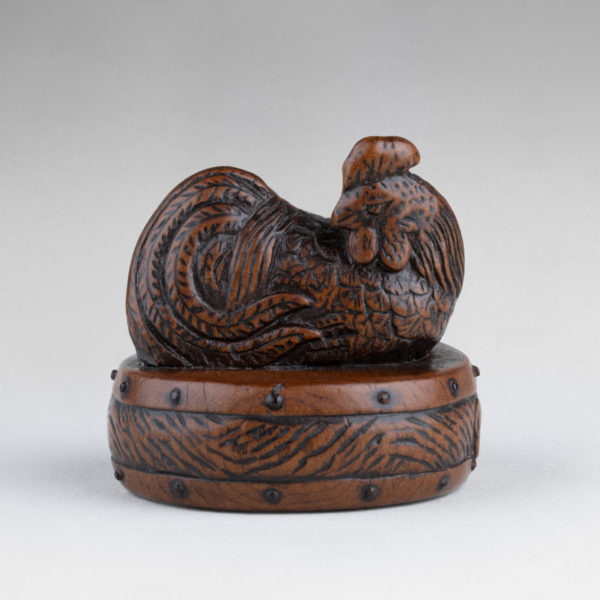
Netsuke par Tametaka. Ravissant modèle en bois sculpté représentant un coq perché et couché sur un tambour, regardant vers l’arrière. Signé sous la base. Modèle de belle dimensions. diamètre : 4 cm. Japon Edo -1603-1868) 19e siècle. Le coq sur le tambour est symbole de paix. En effet, les tambours utilisés pour appeler les troupes en guerre n’ayant plus d’utilité en période de calme, se retrouvaient occupés par les animaux, dont les coqs.
Netsuke by Tametaka. A wood model depicting a rooster / coquerel resting on a drum. The long-tailed fowl sits perched on a war drum, looking back to his right. Horn inlay. Signed under the base. Good size. Diameter : 4 cm. Japan Edo (1603-1868) 19 th century. A rooster resting on a war drum is symbolic of a peaceful era. The war drum was used to call troops to arms, but having fallen into disuse, it has become a perch for fowl.
Netsuke – Personnages et cheval dans une barque
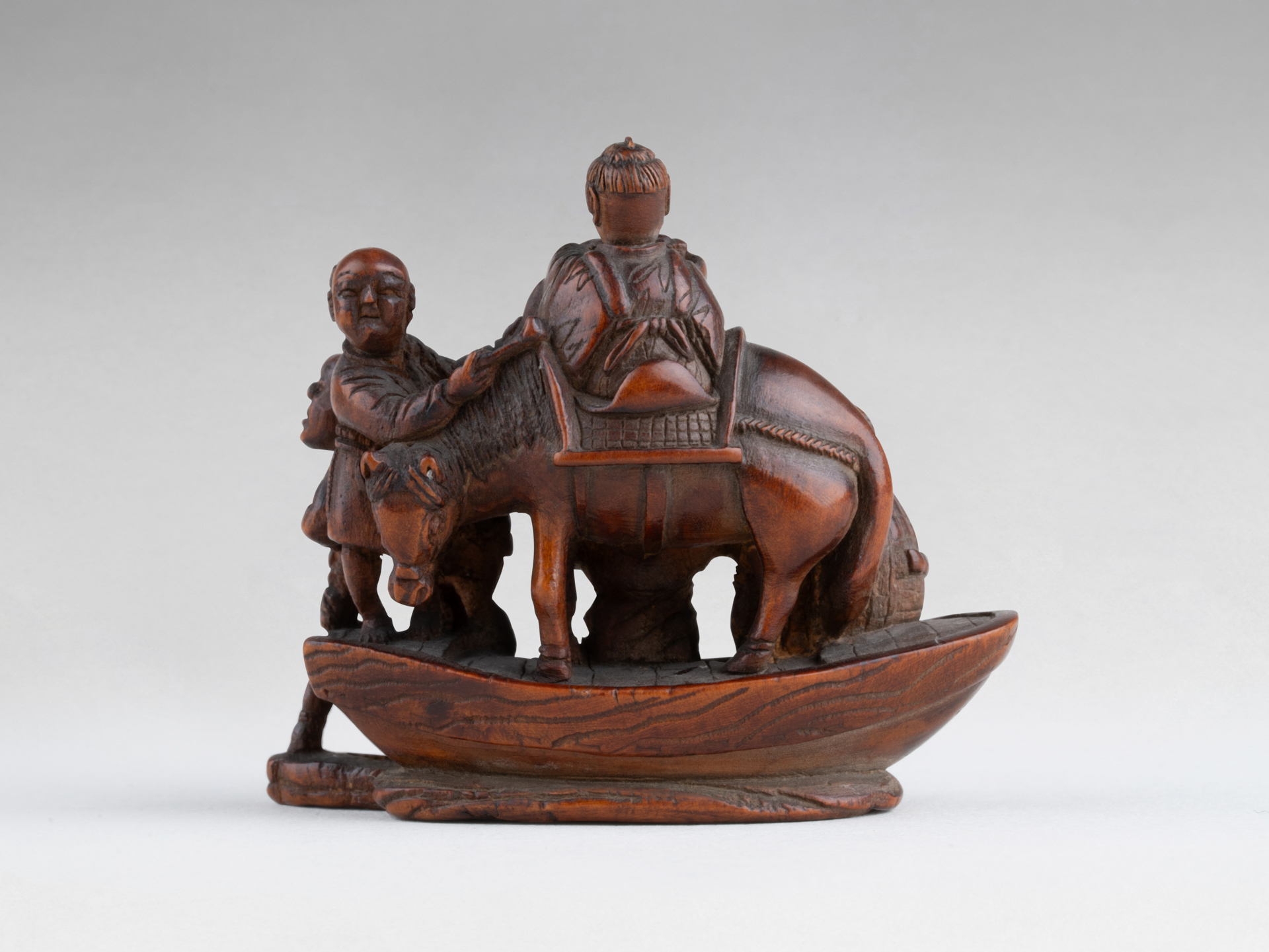
Netsuke – Joli sujet en bois sculpté représentant une barque, avec un cheval et plusieurs personnages, chargés de sacs de marchandises, le barreur penché en avant. Longueur : 5,3 cm. Signé sur le devant de la barque : Norishige. Japon Edo (1603-1868) début Meiji (1868-1912) 19e siècle
Netsuke – A wood sculpture of a boat, with a horse and many characters, carrying bags. Length : 5,3 cm. Signed in front of the boat : Norishige. Japan end of Edo (1603-1868) early Meiji (1868-1912) 19th century.
Netsuke – Deux singes par Itsumin
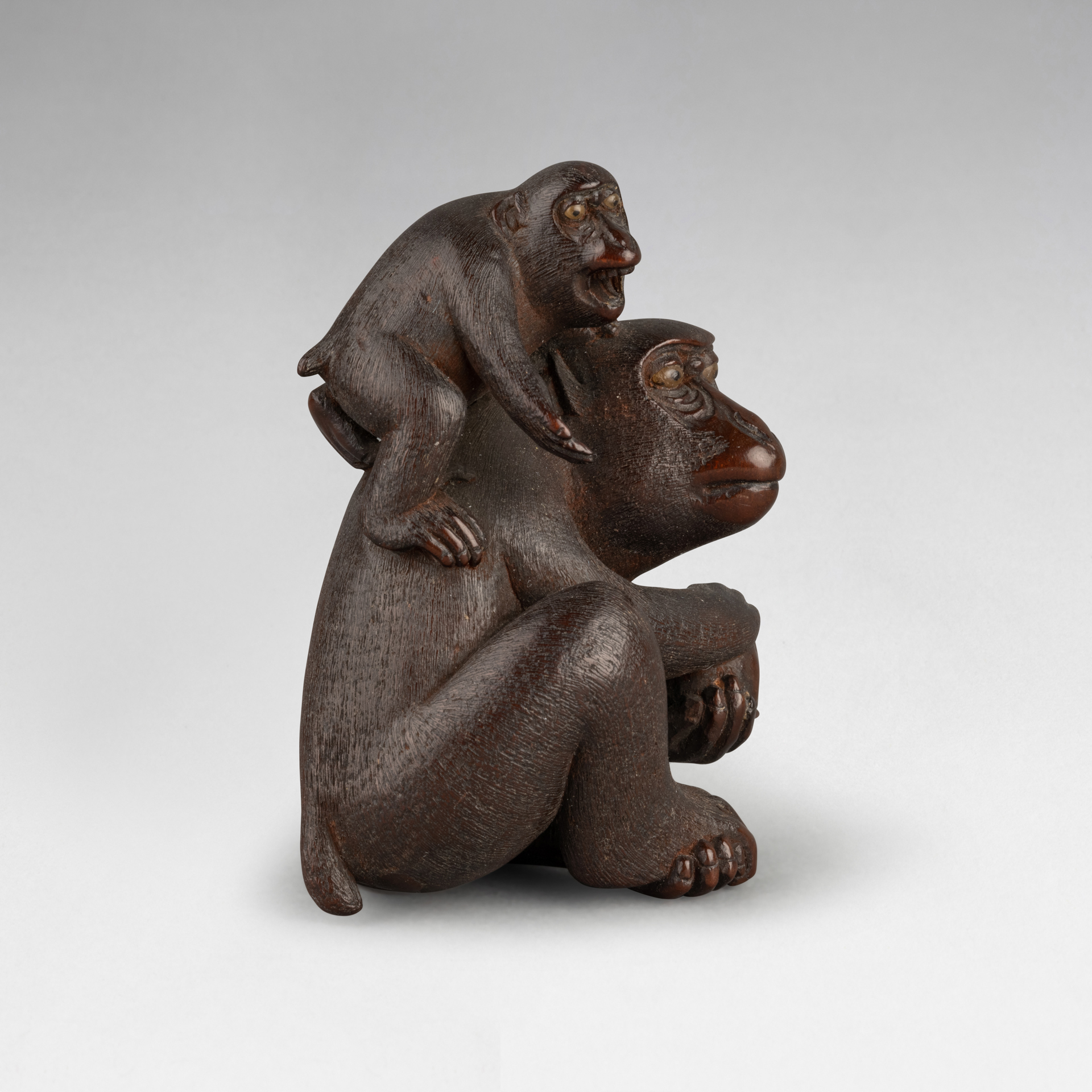
Netsuke – Par Hokyudo Itsumin. Deux singes finement sculptés. Le plus petit grimpant sur le dos du grand singe. Les regards très expressifs. Signé sous la base. Ravissants détails de sculpture. Double incrustation pour les yeux. Hauteur : 7 cm. Japon fin Edo, 19e siècle.
Netsuke – By Hokyudo Itsumin, signed Itsumin. Two finely carved monkeys. The smallest climbing on the back of the big one. Very expressive heads. Signed under the base. Very fine sculptural details. The eyes are double inlaid in pale and dark horn. H: 7 cm. Japan, Edo (Tokyo), end 19th century, Edo period
Prix sur demande – Price on request
Netsuke – Calebasses et leurs feuillages
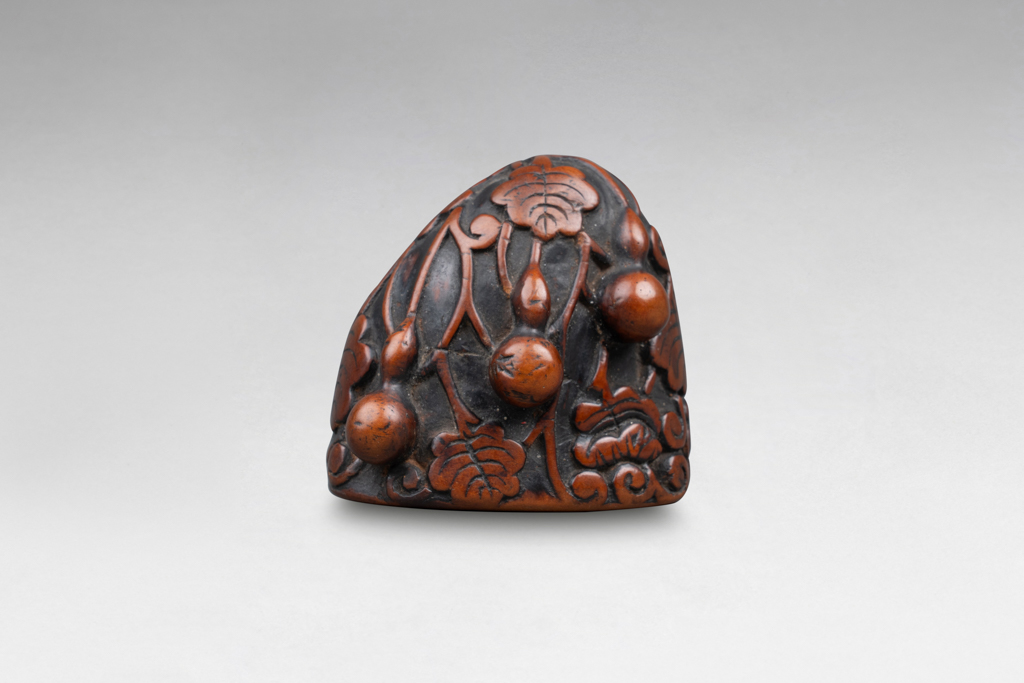
Netsuke – Joli modèle d’un rocher sur lequel sont suspendues des calebasses et leurs feuillages. Belle patine naturelle. Larges himotoshi au dos. Hauteur : 4 cm. Largeur : 4 cm. Japan Edo (1603-1868) 18e siècle.
Netsuke – A woodbox model of a rock with calabash and foliage hanging. A good natural patina. Wide himotoshi on the back. Heigth : 4 cm x wide : 4 cm. Japan Edo (1603-1868) 18th century.
Netsuke – Saigyo Hoshi regardant le Fuji
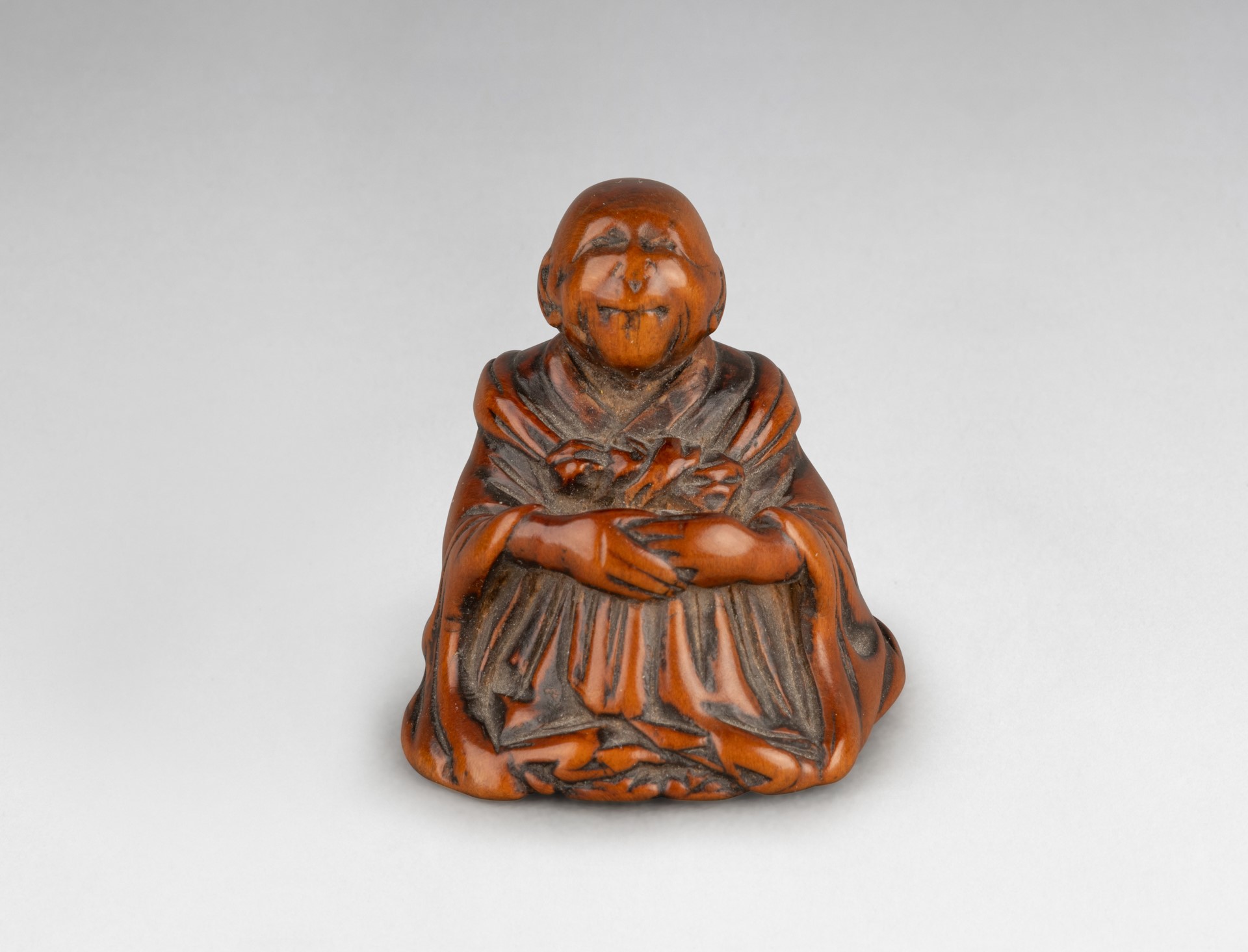
Netsuke – Rare et intéressant sujet en buis sculpté figurant un célèbre poète appelé Saigyo Hoshi ou Saigyo le moine, qui vécu au 12e siècle, à la fin de l’époque Heian et au début de l’époque de Kamakura. Il est représenté assis, regardant loin devant lui le Fuji. Dimensions : 3 x 3 cm. Belle patine naturelle. Japon Edo (1603-1868) 18e siècle.
Netsuke – A rare, very good and interesting model of a monk seated, looking at the Fuji. The man depicted is Saigyo Hoshi the poet, who lived in the 12th century at the end of Heian, and the begining of Kamakura era. The man beams and stares off into the distance. Dimensions : 3 x 3 cm. Japan Edo (1603-1868) 18th century.
Netsuke – Shoki et Oni par Hidemasa

Netsuke – en buis représentant le couple Shoki et Oni, Shoki marchand, son épée à la main. Le petit démon Oni luttant perché sur le large chapeau d’Oni. Jolis détails de sculpture. Manque la poignée du sabre de Shoki. Signé au dos Hidemasa. Hauteur : 5,8 cm. Japon Edo (1603-1868) 19e siècle.
Netsuke – A woodbox model of a figure of Shoki and Oni. Shoki is standing, its sword in his hand. He is wearing its long robe. The small demon crouching over the larg hat, is struggling. Beautiful details. Some lack of the sword. Heigth : 5,8 cm. Japan Edo (1603-1868) 19th century.
Sashi Netsuke – Saumon séché
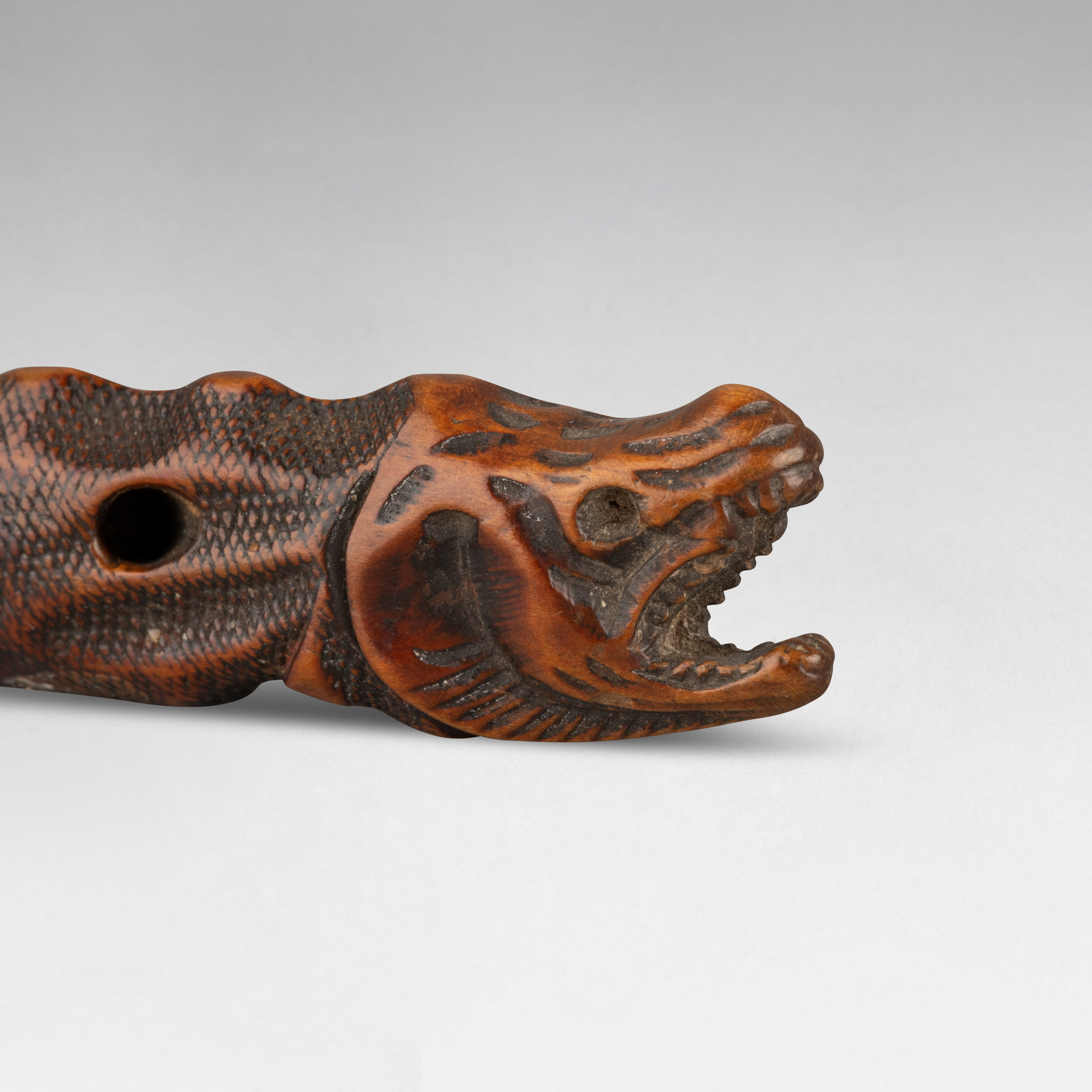
Sahi Netsuke – Large saumon séché en bois sculpté. La tête très expressive et larges creux dans le corps de l’animal. Belle patine. Himotoshi au revers. Japon Edo (1603-1868) fin du 18e siècle, début du 19e siècle.
Sashi Netsuke of of wood dried fish sculpture. The head very expressive and wide hollows in the salmon. Good patina. Himotoshi on the back. Japan Edo (1603-1868) end of 18th, very early 19th century.
Netsuke – Grenouille sur queue de coloquinte
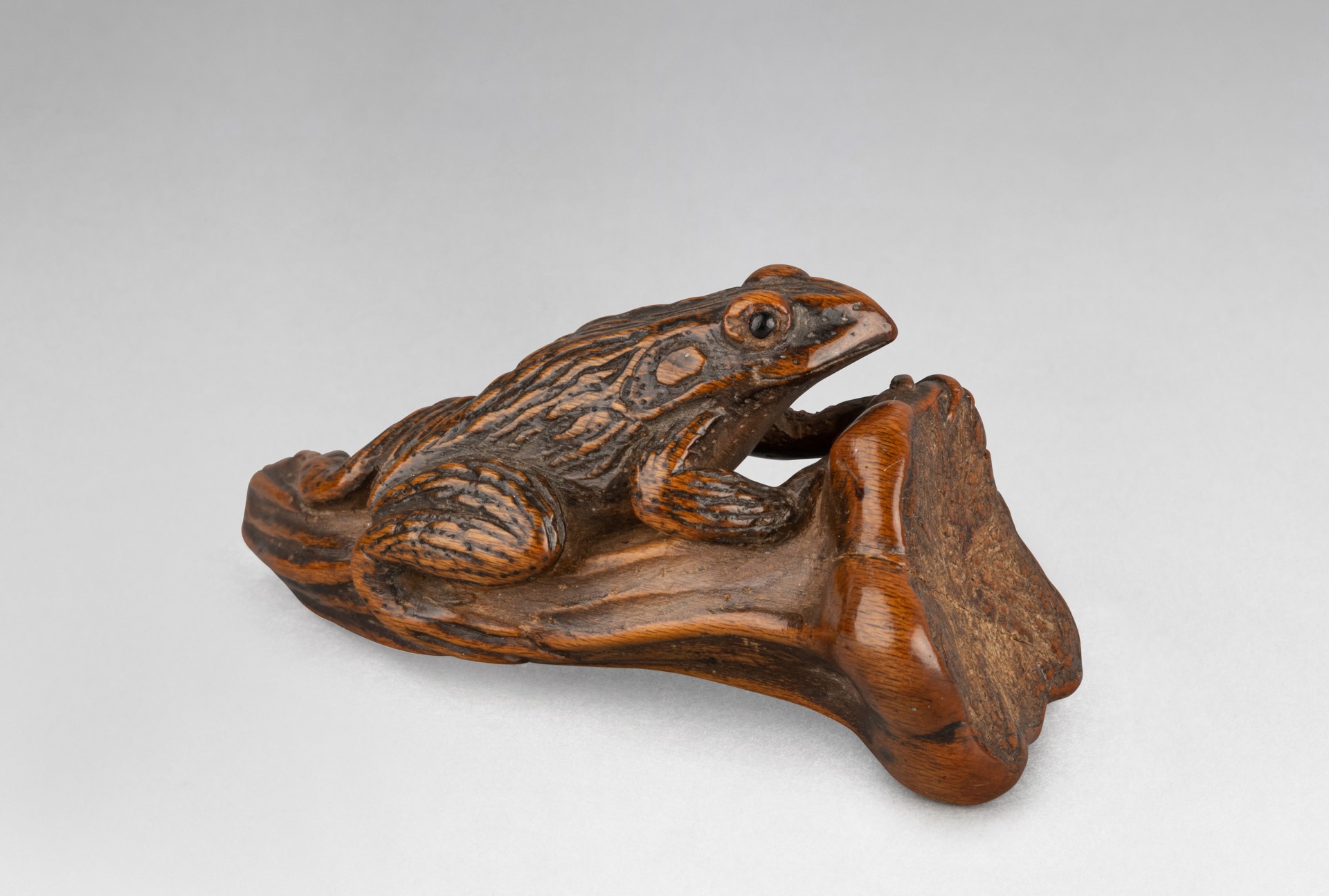
Netsuke – Inhabituel et superbe modèle d’une grenouille perchée sur une queue de coloquinte en bois sculpté. Buis. Incrustation de corne brune pour les yeux. Très jolis détails de sculpture dans le rendu de la peau de l’animal et dans l’aspect de la queue / tige de coloquinte. Longueur : 6,2 cm. Japon Edo (1603-1868) 19e siècle.
Netsuke – Unusual and superb model of a boxwood frog on a pumpkin stalk. Eyes inlaid with brown horn. Lovely and very fine detail of sculpture, in the skin of the frog or the pumpkin salk. Length : 6,2 cm. Japan Edo (1603-1868) 18th century.
Netsuke – Karako dans le sac aux trésors de Hoteï
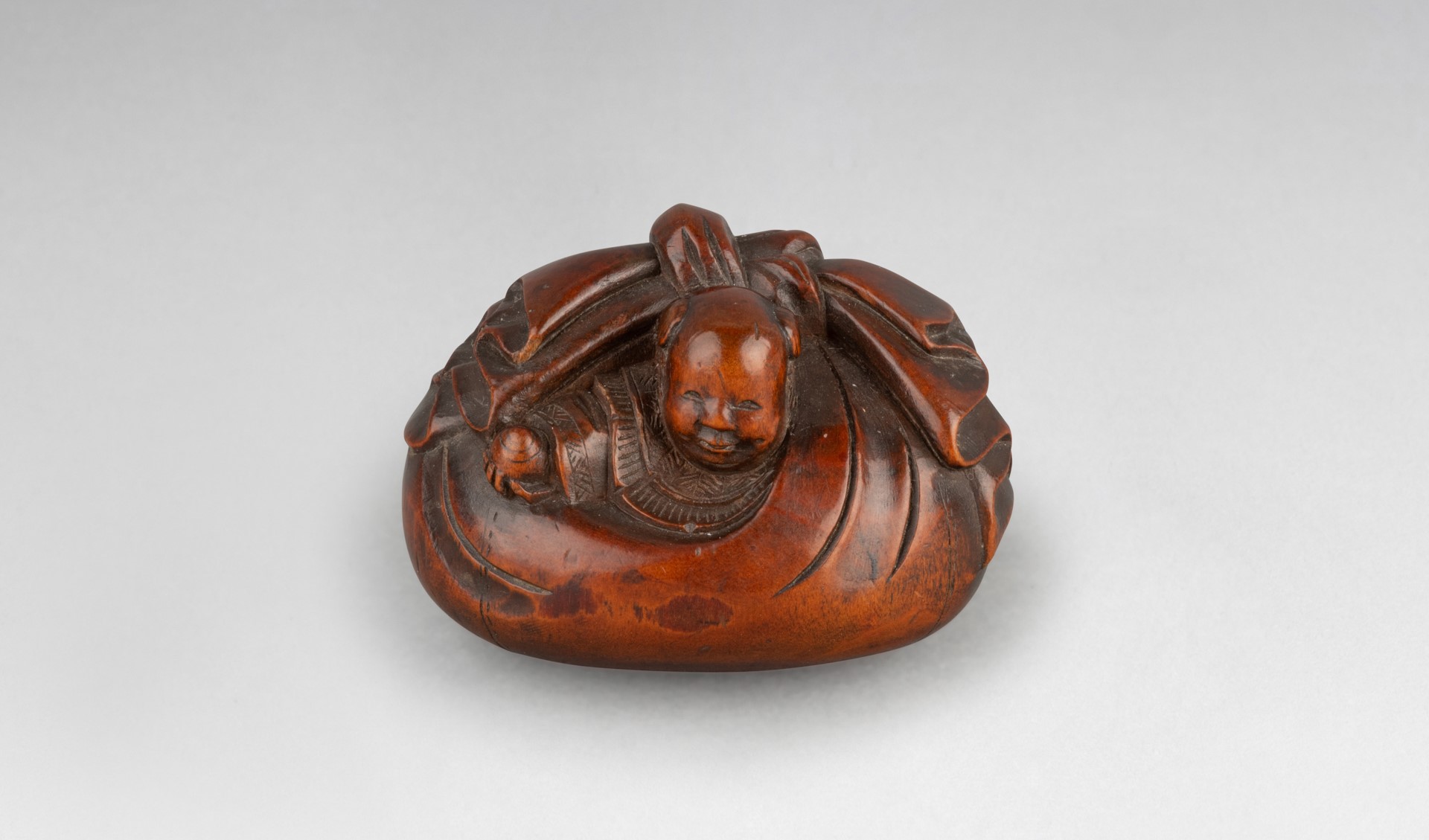
Netsuke – Petit et charmand modèle représentant un karako sortant du sac aux trésors d’Hoteï. Belle patine du bois. Jolie finesse de sculpture. Longueur : 3,6 cm x Hauteur : 2,4 cm. Japon Edo (1603-1868) 19e siècle
Netsuke – A small and charming model of a karako going out of the bag of treasure of Hoteï. Good natural patina and finely carved. Length : 3.6 m x Height : 2.4 cm. Japan Edo (1603-1868) 19th century.
Netsuke – Ravissant daim couché
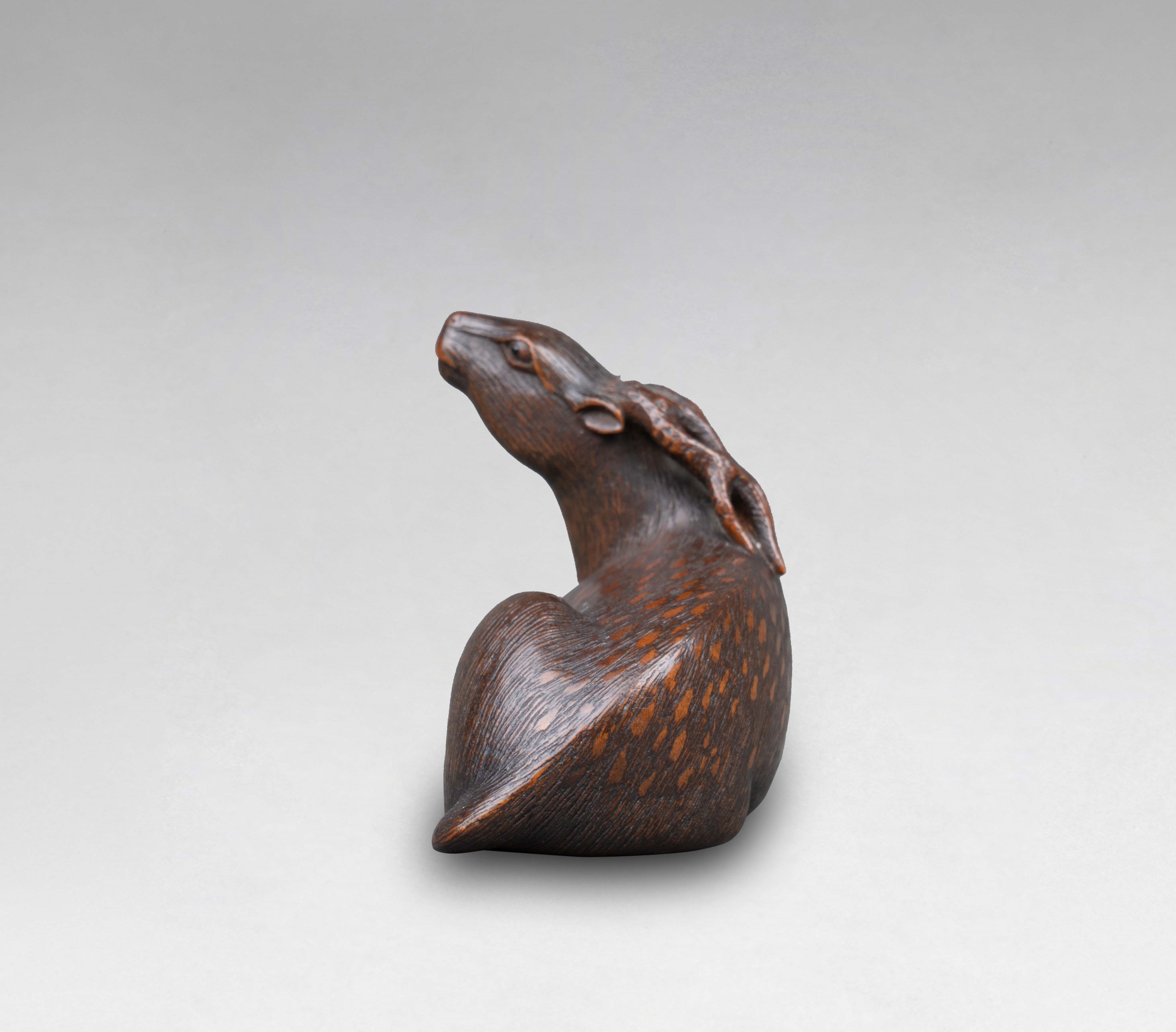
Netsuke – Rare modèle d’un ravissant daim en bois sculpté, représenté couché, la tête légèrement relevée, ses pattes rentrées sous son ventre dans une attitude très gracieuse. Ses bois retombant le long de son cou et du dos de l’animal. Ravissant pelage aux tâches reconnaissables. Belle finesse de sculpture pour un modèle de belle taille. Hauteur : 3,4 x longueur : 4 cm. Japon Edo (1603-1868) 19e siècle.
Netsuke – Rare and very fine model of a reclining deer, carved, lying, with the head slightly raised, the staghorns falling down its back and its legs folded beneath, the hairwork is well carved and easily recognizable. Beautiful details of sculpture for a good size. Hight : 3.4 x Length 4 cm. Japan Edo (1603-1868) 19th century.
Netsuke – Cachet avec scène de village sous des pins
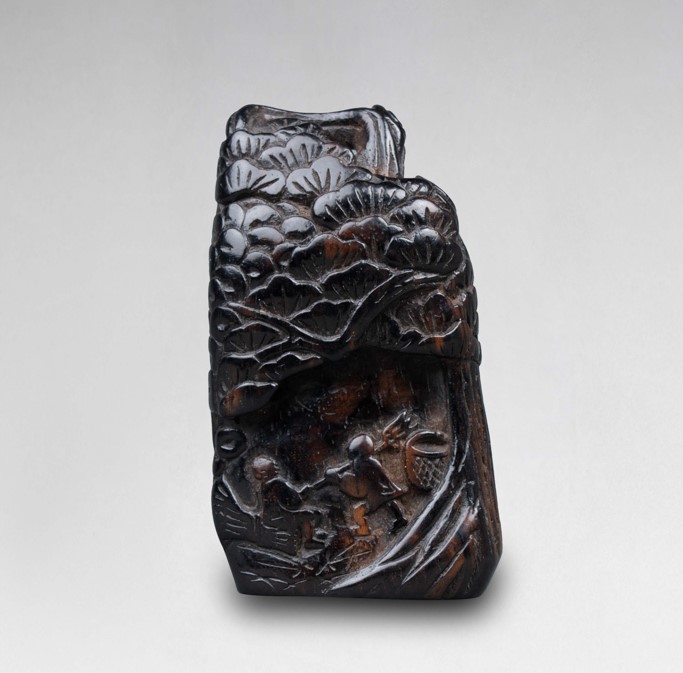
Netsuke – Belle forme inhabituelle pour un modèle de bonne dimension, représentant une petite scène de village sous des pins. En bois de kurokaki ou kokutan, qui s’apparente au plaqueminier. Il porte une date au dos (1838). Porte le cachet Sei. Hauteur : 6,4 cm. Japon Edo (1603-1868) 19e siècle.
Netsuke – A lovely and unusual big shape for this model of a village scene, with pine trees. Kurokaki or kokutan wood. A date of 1838 on the back and a signature of Sei under the base. Hight : 6,4 cm. Japan Edo (1603-1868) 19th century.
Karako soulevant le sac de Hotei, par Masakiyo
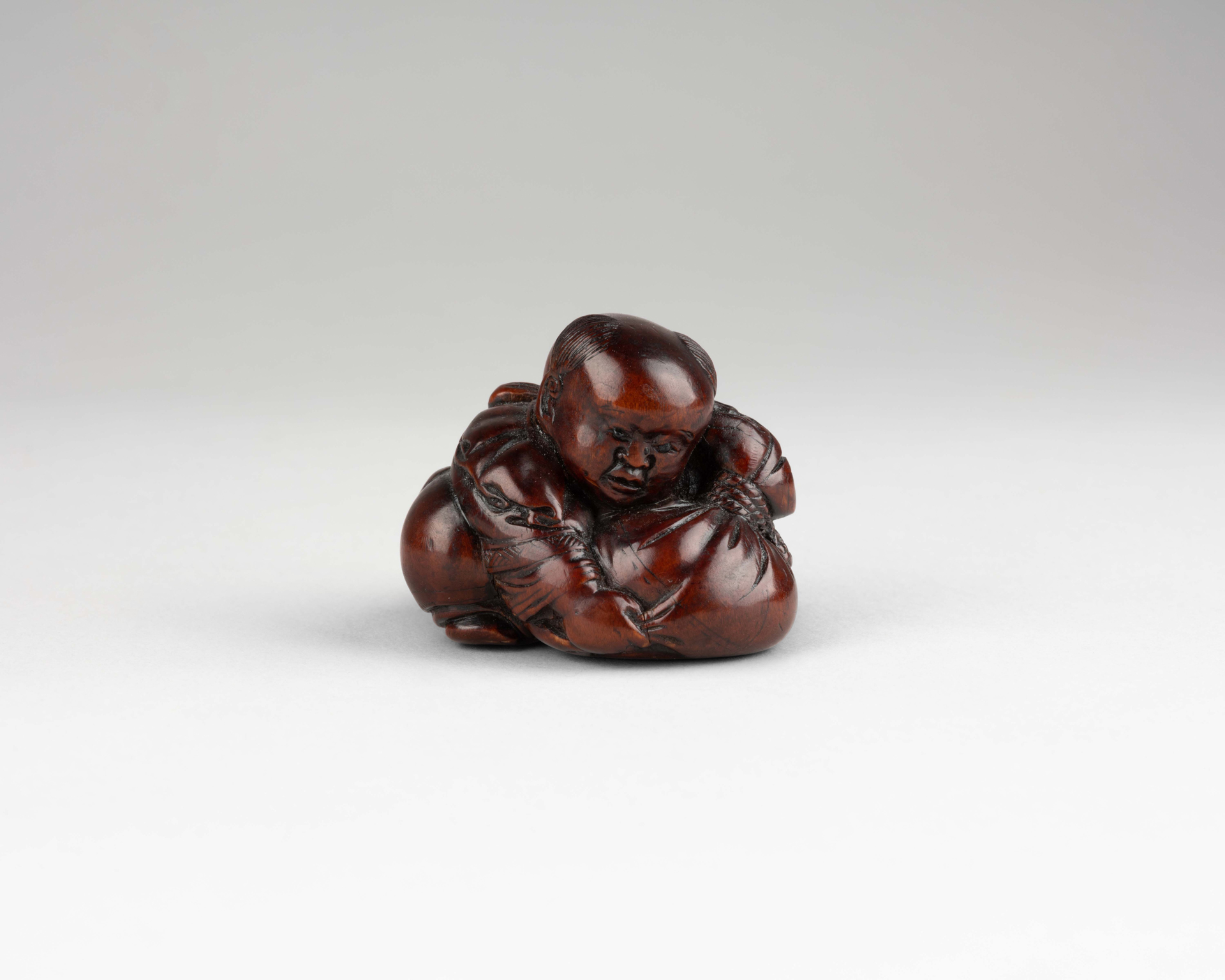
Netsuke par Masakiyo- Très joli modèle en bois sculpté représentant un Karako (enfant chinois) agenouillé, essayant de toutes ses forces, de soulever le sac de Hotei. Ravissants détails sculpté. Japon Meiji (1868-1912) fin du 19e, début du 20e siècle. Hauteur : 2,9 x 3,3 cm. Signé sous la base : Masakiyo jeune (lignée de Masanao).
Netsuke by Masakiyo – A good wood netsuke of a Karako (chinese child) wearing festive robes with trying to lift Hotei’s large bag. Very fine details. Japan Meiji (1868-1912) end of 19th, early 20th century. Dimensions : 2,9 x 3,3 cm. Signed under the base ; Masakiyo young (branch of Masanao)
Netsuke – Shichifukujin Takarabune, le bateau des 7 dieux du bonheur
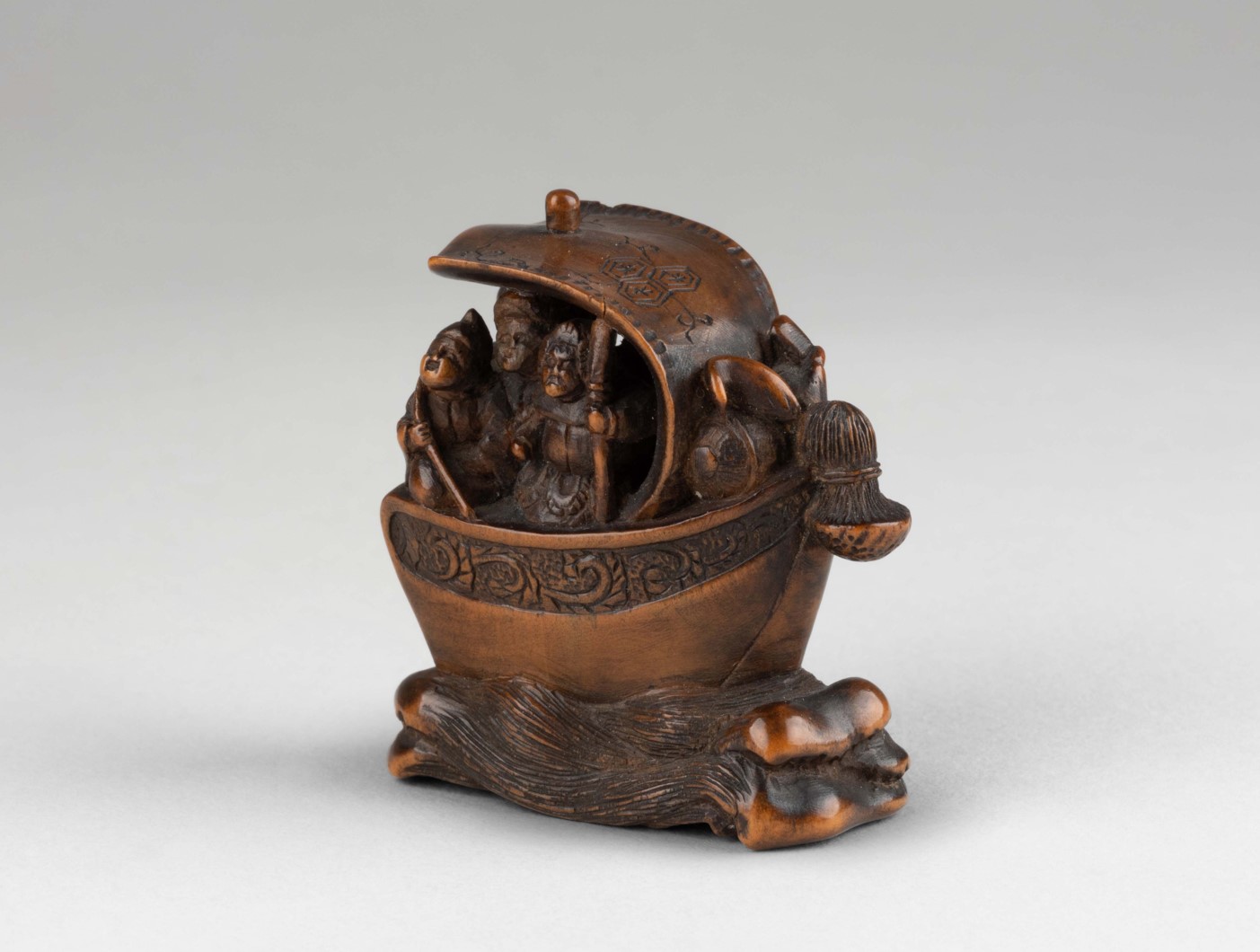
Netsuke – Joli modèle du Shichifukujin Takarabune (Le célèbre bateau chargé de trésors des 7 dieux du bonheur) en buis sculpté. Jolis détails de sculpture de l’ensemble de la composition. Les 7 divinités sont toutes identifiables, le bateau lui-même est orné, les flots et une petite tortue Minogame sculptés sur la base. La signature en cartouche a disparu avec le temps. Très belle patine naturelle. Hauteur : 3,5 cm. Japon Edo (1603-1868) 19e siècle.
Netsuke – A good boxwood model of the Shichifukujin takarabune (Seven gods of good fortune in the famous treasure boat). Very fine details of sculpture, with the 7 gods that can be identified, the boat with beautiful patterns and carved with the waves and a Minogame on the base. Signed but the signature, as a reserve, has gone. H : 3,5 cm. Japan Edo (1603-1868) 19th century.
